An eclectic assortment of Lucky Thirteen updates:
First up is the last of the phenolic instrument panels – the bombardier’s oxygen panel. This one presented a greater challenge than the other oxygen panels. Not only was it larger than the others, but it was also the first panel in the project for which the blueprints require ultraviolet markings. Since UV markings will be required on the cockpit instrument panel, the bombardier’s oxygen panel was a natural testbed. The markings were printed by DryTransfer.com of Minnesota, who did a fantastic job with the difficult task of printing UV transfers.
From time to time, we encounter blueprints where the Boeing engineers got lazy, simply tracing an object rather than providing measurements. This was one such piece, and careful measuring was required of nearby pieces to ensure that the finished product was, in fact, the correct size. This was helped by our friend Donald Keller of B-17 Air Depot, who located for us an original windshield wiper faceplate. While Lucky Thirteen did not have a bombardier’s windshield wiper, bombardier’s oxygen panels for late-B-17Fs were still issued with the mounting holes for the wiper controls just in case. Don’s plate will later be used for the cockpit windshield wipers.
Next up is the FT-248 T-bracket for the SCR-595 IFF (Identify Friend or Foe) System. Some of you might recall that our IFF system was donated by Jack Antonio of Warner-Robins, Georgia. Jack donated this unit fully restored, complete with test units to demonstrate its operation. The major exception here was the T-bracket for mounting the system’s controls to the wall. This is not unusual. Often, the rarest pieces of wartime radio equipment are those pieces which mount the gear to the airframe – those innocuous pieces overlooked when stripping the airplane for parts. The team at Warbirds Of Glory was able to locate an original FT-248 and were kind enough to provide us with the measurements to recreate this piece.
For most of the B-17’s run, the IFF’s controls were mounted above the radio operator’s desk. Since we have been working Sta. 5, we are ready to mount the FT-248. As so often noted, most of our volunteers work from home, and Bob Hachmann of Peosta, Iowa recreated this part for the bomber. Wartime photos revealed that the part number for this bracket was stenciled on. Using a close-up photo located by volunteer Karl Hauffe of Decatur, Illinois, I was able to recreate this stencil for our FT-248. Thanks guys!
Lastly, we have some news on the turrets – some good, some bad.
The good news is that we have acquired some new reference material on the A-1 Upper Turret. Going through it, carefully taking notes, we learned an interesting fact.
You see, we have been able to establish that the top turret on Lucky Thirteen was built by Emerson Electric of St. Louis, Missouri because of the type of dome which was installed. And, due to the time in which she was in service, we have also established that this unit almost certainly carried an oxygen-swivel type base – a feature that entered service at the same time as the second variant hand control. Emerson-built A-1 turrets cover serials E-1 through E-2700, and since we can limit our A-1 to those with the previously said features, the A-1 on Lucky Thirteen likely had a serial between E-1850 and E-2700.
Thanks to our new reference material, we recently learned that the rails on the turret (the V-shaped pieces which the gunner stands inside) changed from aluminum to steel with serial E-1944. This means that there is an 89% chance that the top turret on Lucky Thirteen had steel rails. Now, most surviving B-17 top turrets are Frankenstein amalgamations, so it was with some difficulty that we finally found one with steel rails – the top turret on Boeing Bee at the The Museum of Flight in Seattle, Washington. We have reached out to them about measuring these pieces for us so that we can document them and recreate the long lost blueprints. Should be interesting!
The bad news is that we have been contacted with an offer for an early A-1 Top Turret mounting ring. This is the toothed ring assembly which mounts to the B-17’s fuselage, in which the turret rotates. The price the seller is asking for is 10,000 USD. Like the Type A-2 Ball Turret Trunnion and Hanger Assembly we were offered last year at 25,000, this piece is more than we can afford without help. So far, both are still available, though there are collectors with deeper pockets who may swoop them up if we are not lucky. I know that this is a lot to ask of our supporters, but if anyone can help with these needs, you know where to find us!

The finished bombardier’s oxygen panel for Lucky Thirteen.
The upper holes are for the bombardier’s windshield wiper controls. These were found on B-17F bombardier oxygen panels regardless of whether or not a bombardier’s windshield wiper was installed. The same is true for the glide bombing plug, as Lucky Thirteen never carried a Glide Bombing Attachment for her Norden bombsight.
The static pressure valve switch was donated by Joe McKowen of Gaffney, South Carolina. The oxygen pressure gage was donated by Steve Hester of Falls City, Texas. The Type A-1 Oxygen Flow Indicator came from Fagen Fighters of Granite Falls, Minnesota.
Photo taken 19 March 2023.
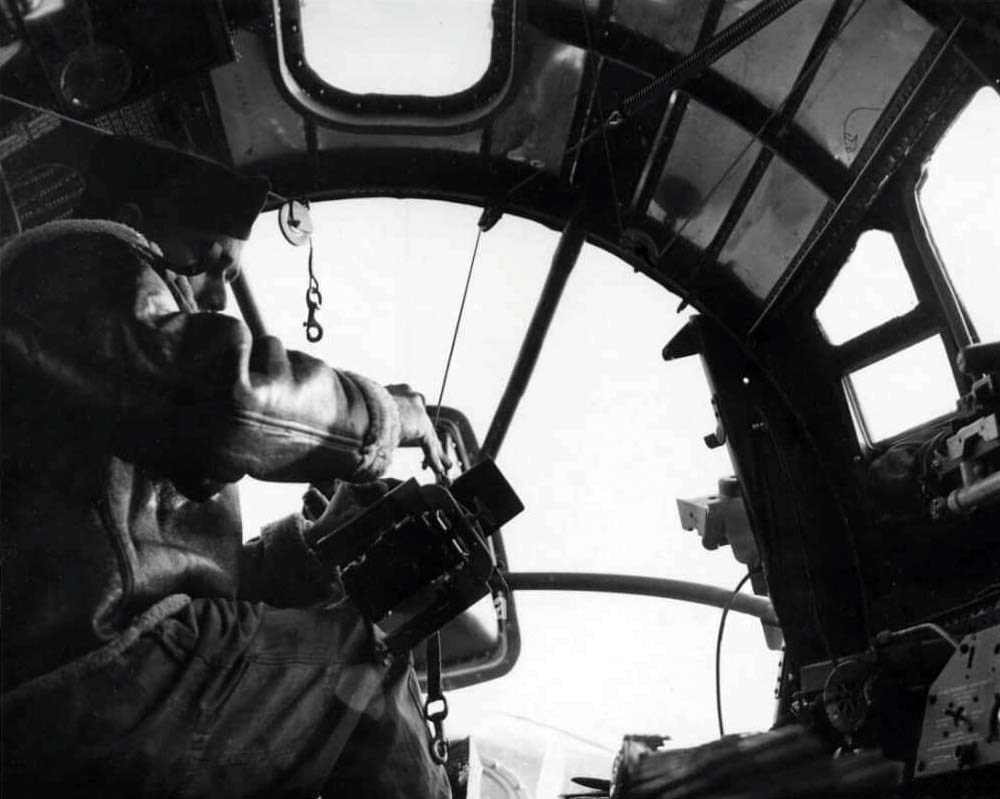
An armorer at RAF Honington at work in the nose of a late-B-17F. Judging by the lack of insulation, this is one of the very last of the B-17Fs.
Note the bombardier’s oxygen panel on the far right. Even though this aircraft does not have a windshield wiper for the bombardier, the panel still has holes in the top for its controls.

The newly finished FT-248 bracket.
Photo taken 18 March 2023.
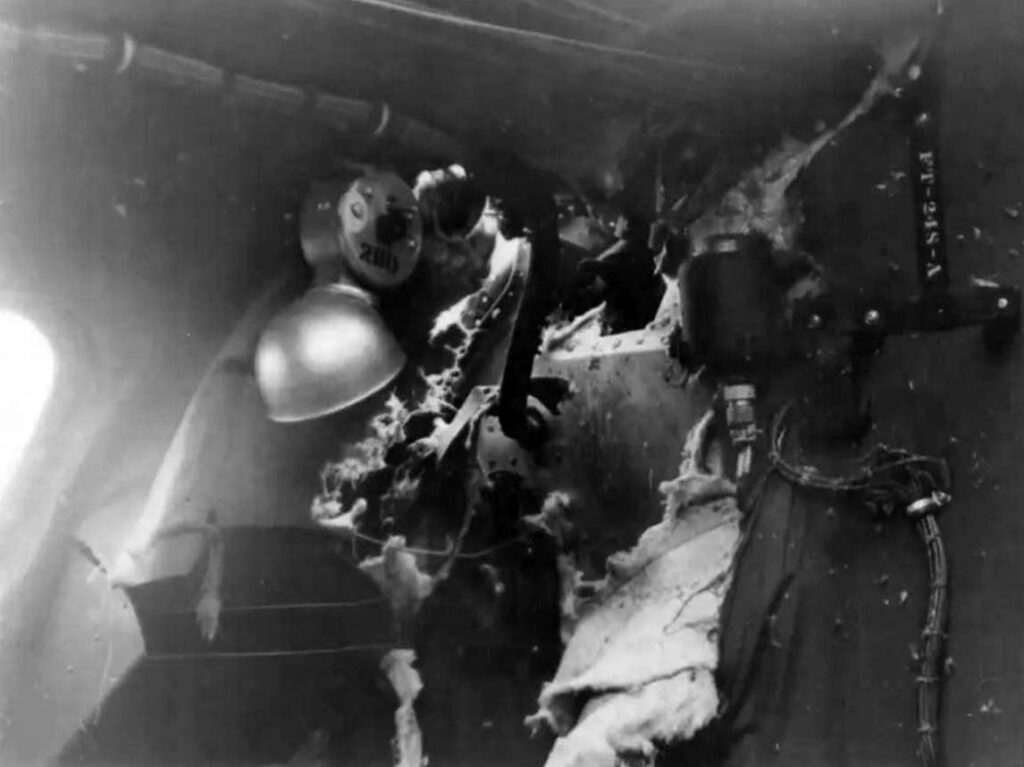
The area above the radio operator’s position on an early B-17F. Note the FT-238 bracket on the upper right – the control boxes have been disconnected from the bracket. Like the Norden bombsight, photographers were forbidden to photograph IFF system components for much of the war.
The fact that this is an older B-17F can be ascertained by the type of light installed here. Later B-17Fs used lights made of hard plastic.
Note how the insulation and fabric, normally glued to the wall, have been peeled back due to damage.
Photo taken 19 November 1942.

Manual photo showing the steel type rails for the Type A-1 Upper Turret.
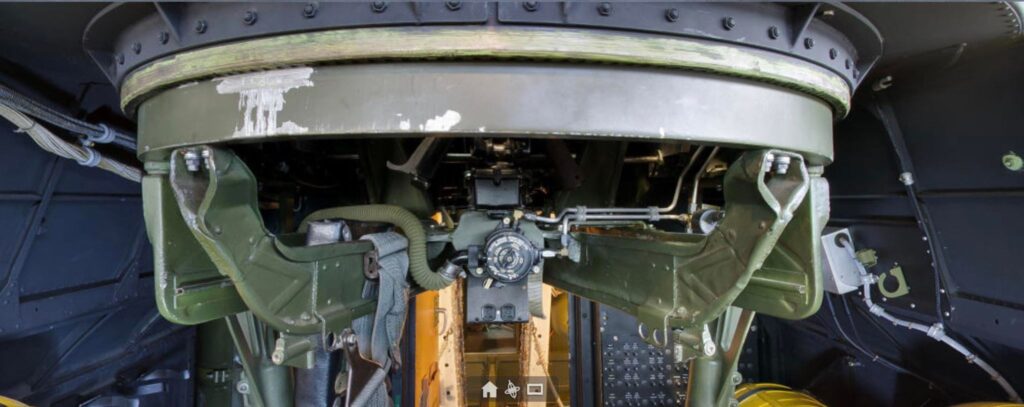
The steel rails installed on the top turret of Boeing Bee 42-29782 at the Museum of Flight in Seattle, Washington.
Despite being the more common rails in wartime, these steel rails appear to be one of the only surviving examples.
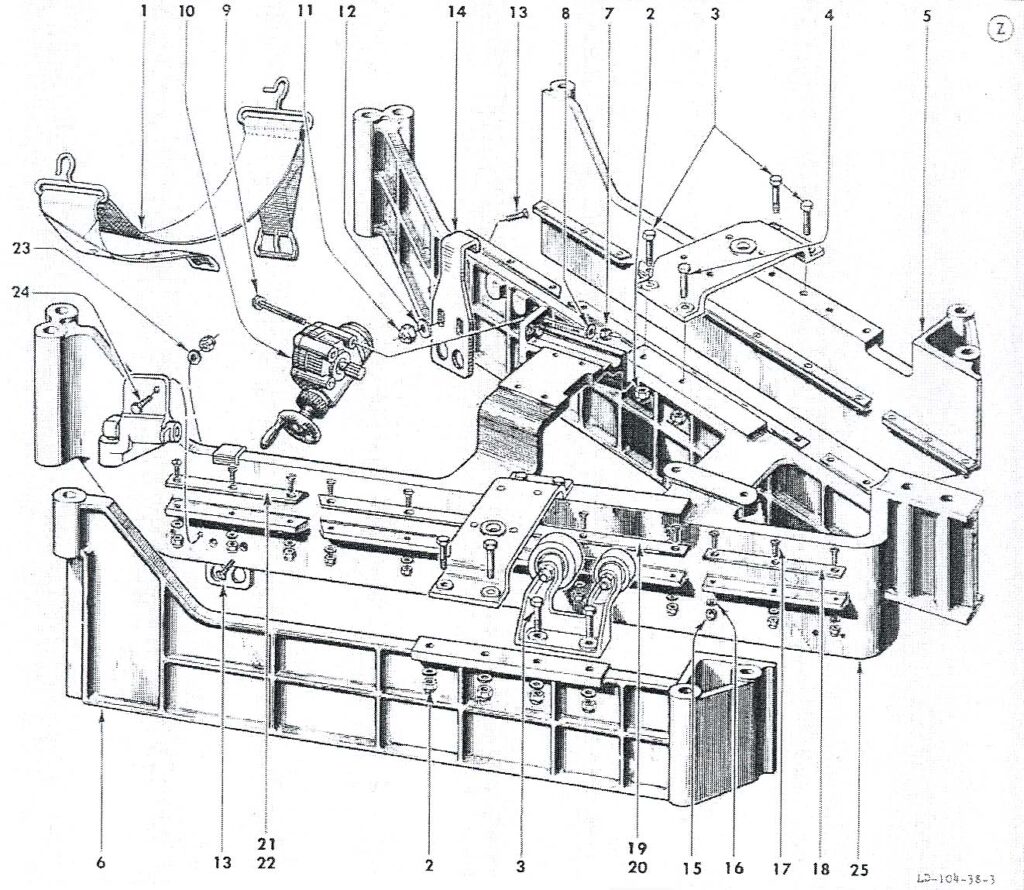
Manual photo showing the cast aluminum type rails for the Type A-1 Upper Turret.
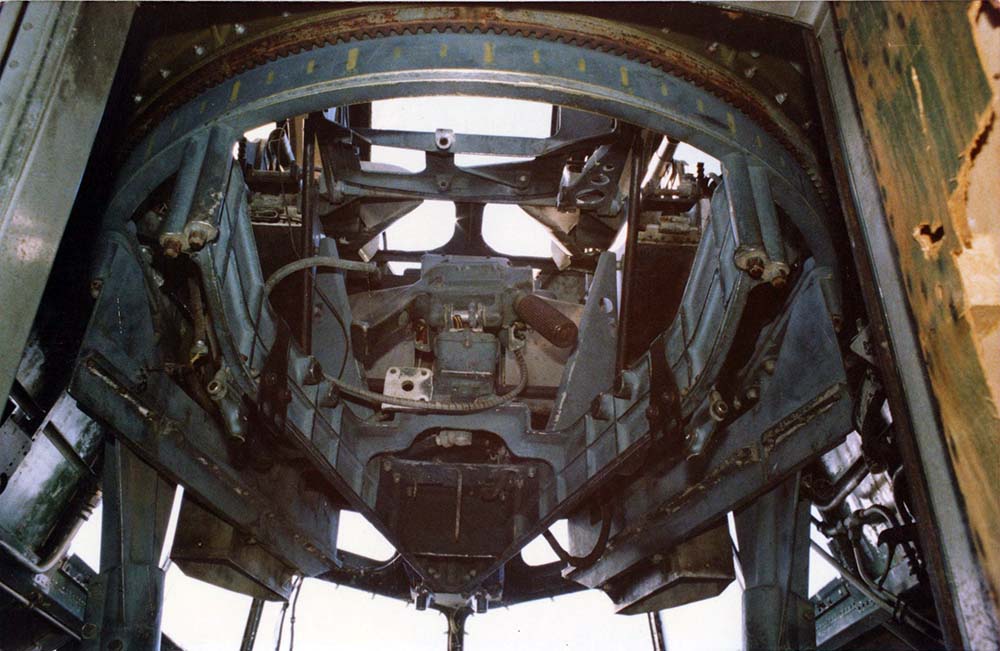
The cast aluminum rails to the Type A-1 Upper Turret on Memphis Belle (41-24485, 91BG). This photo was taken by Karl Hauffe in 1979, prior to the aircraft’s multiple restorations.
Note the hand control on this turret – it is not original. At some point the original hand control (which had a thumb wheel for adjusting range) was replaced with a later unit (which had a motorcycle grip for adjusting range).
We do not know if this change was done in combat service or when the Belle was a training aircraft. Today she is displayed with the older style hand control.
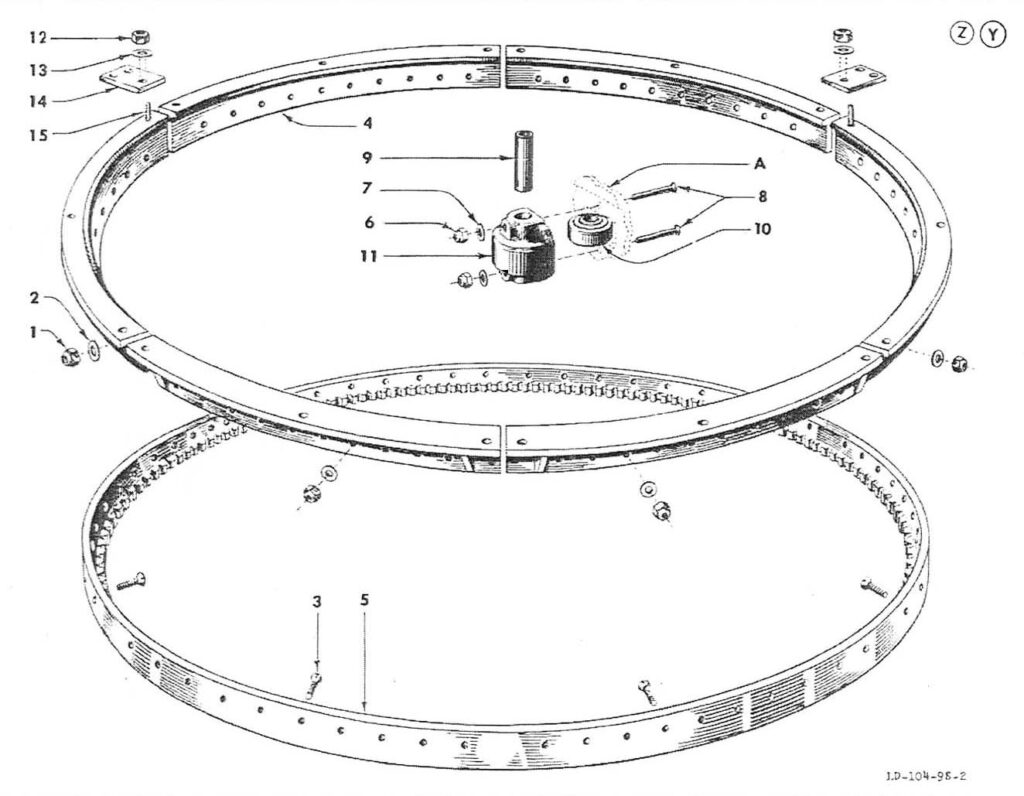
Manual photo showing the mounting ring for the Type A-1 Upper Turret.
We have been offered one of these for 10,000 USD. We cannot afford this piece without help.
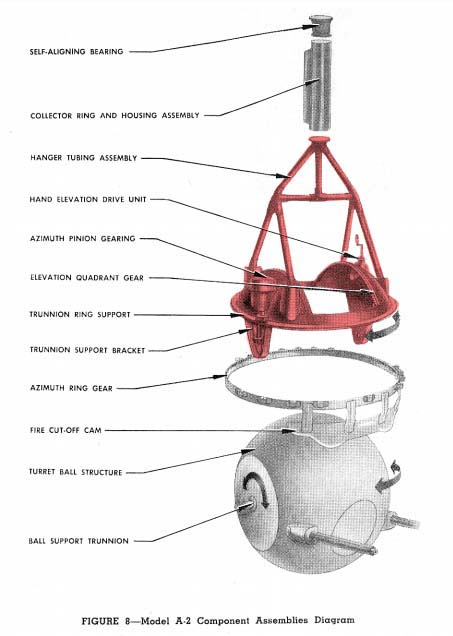
Manual photo showing the Type A-2 Ball Turret’s hanger and trunnion assembly.
We have been offered these pieces for 25,000 USD. We cannot afford these pieces without help.
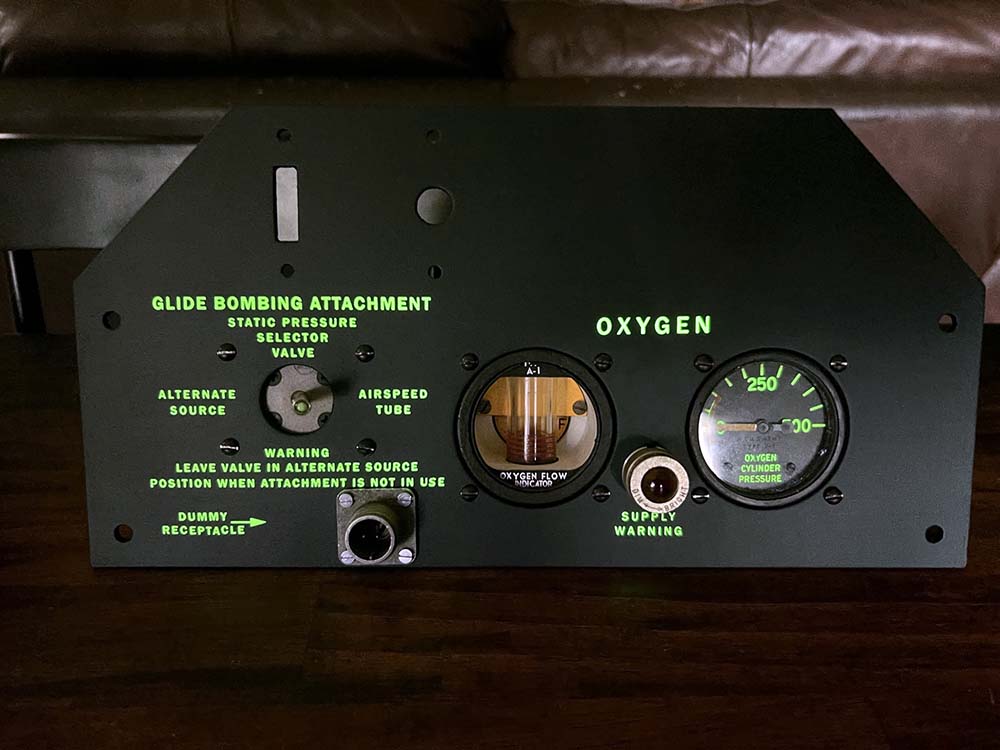
The newly finished Bombardier’s Oxygen Panel after being illuminated with a UV light.
Photo taken 19 March 2023.

The windshield wiper switchplate from Don Keller, compared with a digital recreation printout.
I did this so that we can make a new plate, should it become necessary.
Photo taken 20 January 2023.
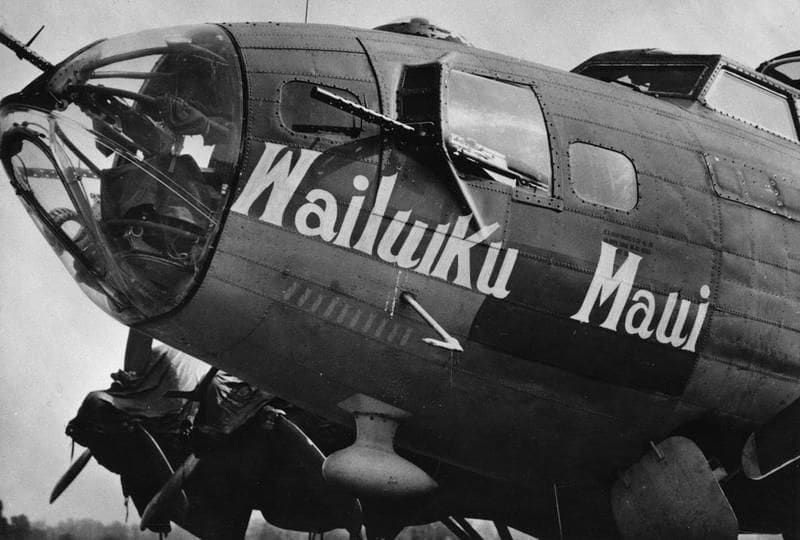
Wailuiku Maui (42-3295, 388BG), a Douglas-F with a bombardier’s windshield wiper installed.
These wipers were apparently not popular as few photos show them installed.
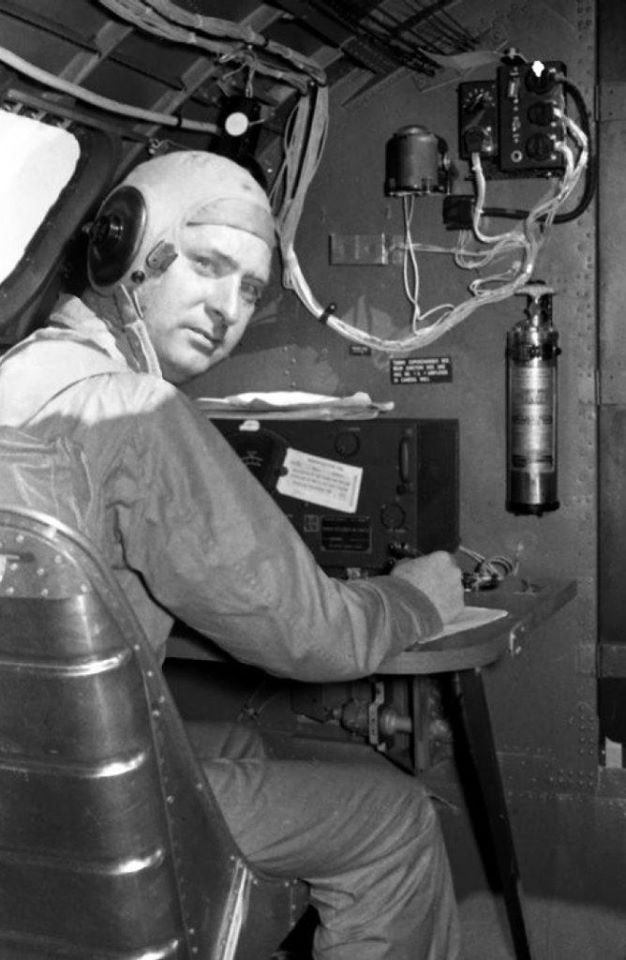
A rare wartime photo – taken aboard a G-model B-17 – which shows the IFF control assembly above the radio operator’s desk.
Note the Type A-2 Carbon Tet. Fire Extinguisher. Volunteer Chris Ely is working to restore the two carbon tet. extinguishers for Lucky Thirteen. If you have any components which can help in this effort – both regarding the carbon tets and the Type A-17 CO2 types – please let us know!
A little tough to see but too awesome not to share –
The first of the interior door trims have been installed for Lucky Thirteen.
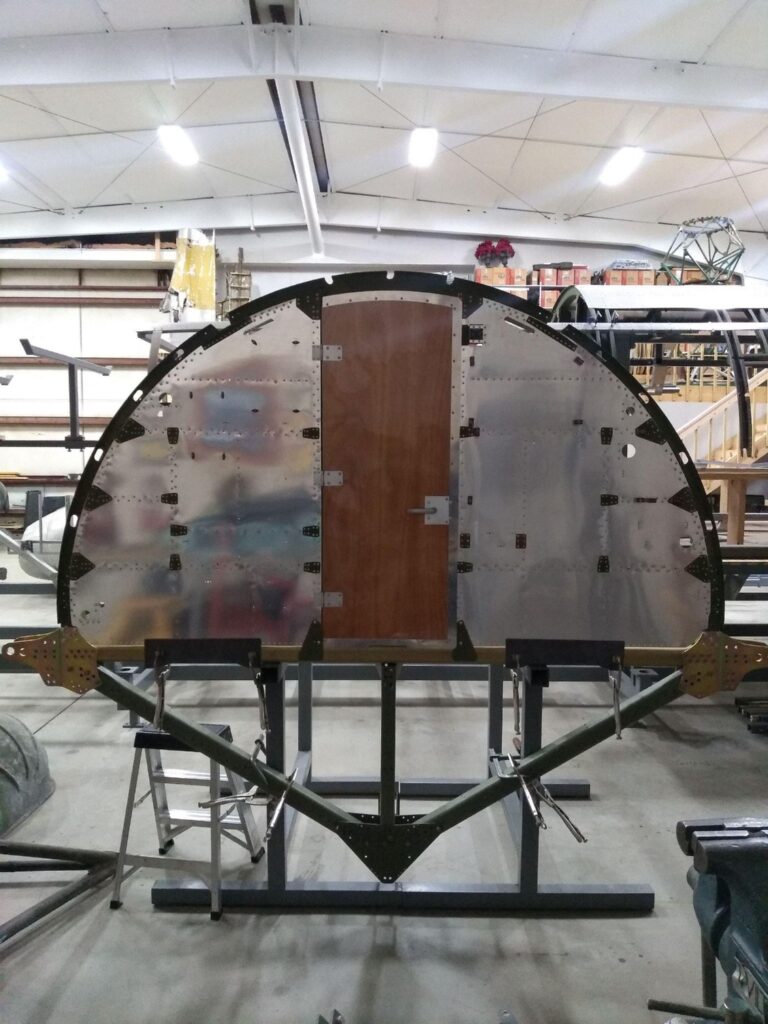
I want to talk about an incredible donation from our friend Richard Boyens. Richard was one of our earliest supporters and recently we finally got to meet face-to-face. Richard brought with him a beautiful BC-375 Transmitter for the SCR-287 Liaison Radio System on Lucky Thirteen.
The Liaison Radio was one of the Boeing B-17’s three radio communication systems, the others being the SCR-274 Command Radio and the SCR-522 VHF Radio. The latter was a line-of-sight system developed by the British and adopted by the US, being mounted on a plywood shelf near the ball turret and utilizing the antenna mast above the waist. The Liaison and Command Radios both used lengths of wire running up the tail. Whereas the Command Radio was a short-range system controlled by the pilots, the Liaison Radio was a long-range system controlled by the radio operator.
To overgeneralize, the VHF was primarily used for communicating with fighter escort, the Command Radio for communication throughout bomber formations, and the Liaison Radio for communicating with the ground.
The SCR-287 consisted of the BC-348 Receiver, mounted on the radio operator’s desk, the BC-375 Transmitter mounted on the wall behind him, the BC-306 Antenna Tuner mounted above the transmitter, and a selection of tuning unit cartridges stowed on the opposite wall. Each tuning unit covered a certain frequency range and was inserted/removed from the transmitter as needed. Earlier B-17s carried a complete set of seven tuning units, though as the war dragged on, this number was parried down.
As the largest radio system of the three, it has taken us some time to assemble a complete and accurate SCR-287. BC-348s are rather common on the collector’s market, but it is rare to find one that has not been converted for home use. Hangar Thirteen volunteer Charlie Liberto worked tirelessly to restore a BC-348 that was complete with its original dynamotor, tracking down the ultra-rare connector plug that connects it to the aircraft’s power supply. Likewise, we recently reached out to the radio community about trading a postwar tuning unit for a wartime model (they may look similar but we wanted to go that extra step to get it right). Rather than trade, Jeremy Schotter of Georgetown, Indiana donated the last of the needed tuning units.
Two of the SCR-287’s components for Lucky Thirteen are NOS: the BC-306, which was donated by Stephen Gerke of Chantilly, Virginia in 2021, and Richard’s BC-375.
Richard said that he purchased this unit while living in the UK, and Charlie is of the opinion that this was a replacement unit, sent to the US Eighth Air Force but never used. Complete with its original shock mount but missing its tubes, this BC-375 is so pristine that beggars belief.
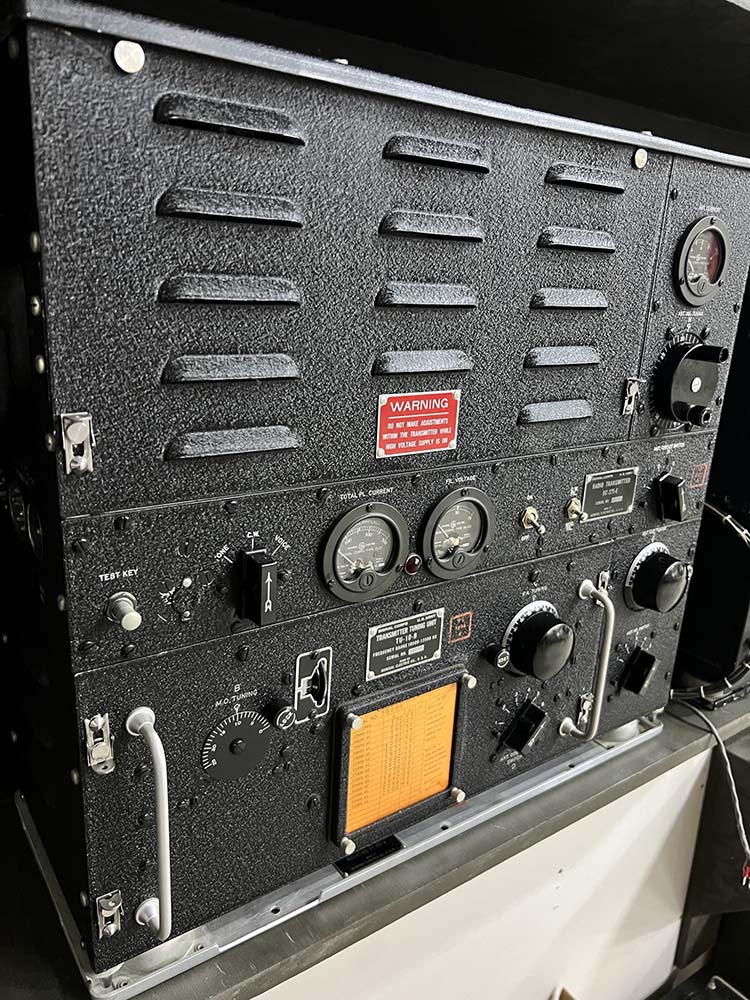
Richard’s newly-donated BC-375.
The Tuning Unit installed is a TU-10-B (10000-12500 KC). The TU-10 is what came standard on newly-issued BC-375s.
Photo taken 8 February 2023.
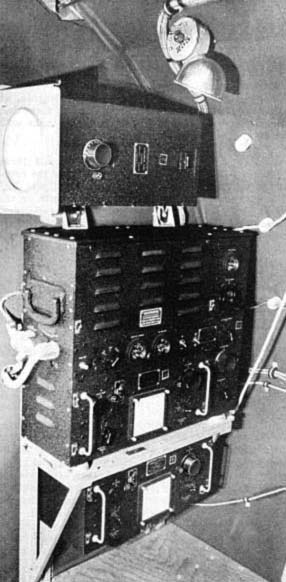
The BC-375 as installed on an B-17E or early-B-17F. Later F-models had a different light fixture hanging above.
Below the transmitter sits the TU-26-B Tuning Unit (200-500 KC). Above sits the BC-306 Antenna Tuner. The BC-306 is mounted sideways and is supported by a pair of FT-115 sway mounts attached to the BC-375.
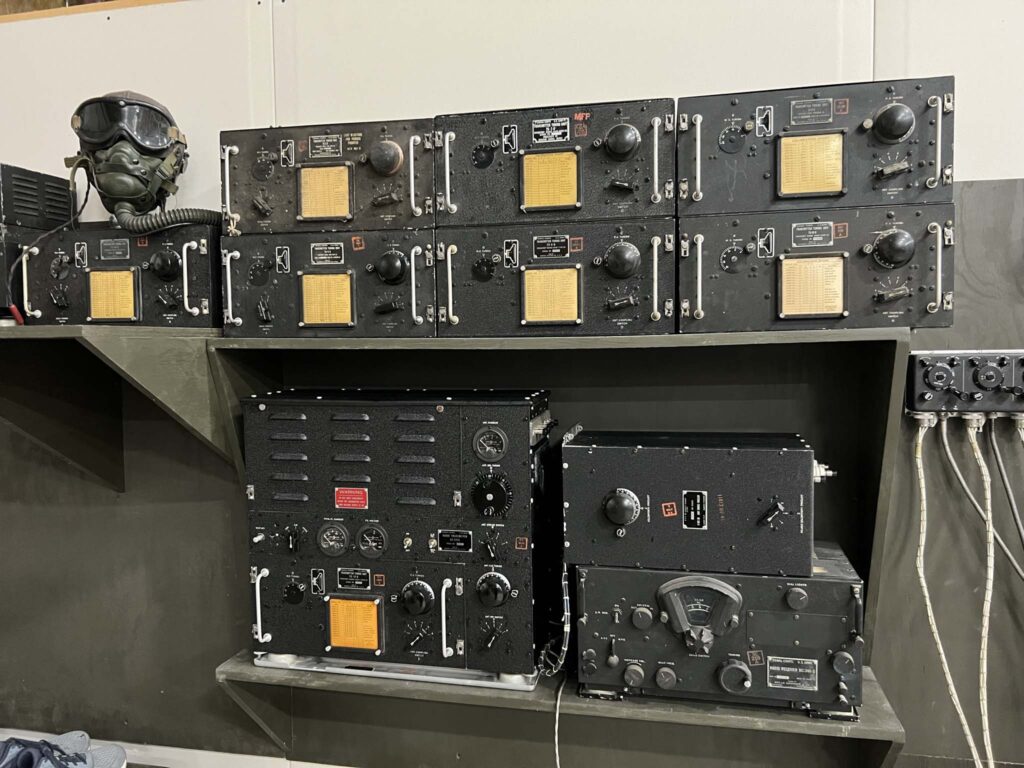
The SCR-287 Liaison Radio system for Lucky Thirteen.
The only component missing from this photo is the PE-73 Dynamotor for the transmitter. Charlie has one in his collection but has asked that we keep an eye out for a replacement. If you can help with this, please let us know!
Photo taken 8 February 2023.

The transmitter assembly for the SCR-287 Liaison Radio aboard a Boeing B-17E. The radio setup you see here was standard on most B-17s.
Five of the tuning units are visible on the left. Between them, they cover frequencies ranging from 1500 to 12500 KC.
Various functions of this system include listening for strike recalls, relaying position in event of an emergency, and communicating weather patterns. Later in the war, special tuning units were introduced that, when tuned to German frequencies, served as a jammer by broadcasting white noise.

The donated BC-306 Antenna Tuning Unit from Stephen Gerke.
This particular unit is an A model, as evidenced by the pair of insulators on top. Later variants had four.
Photo taken 11 February 2021.
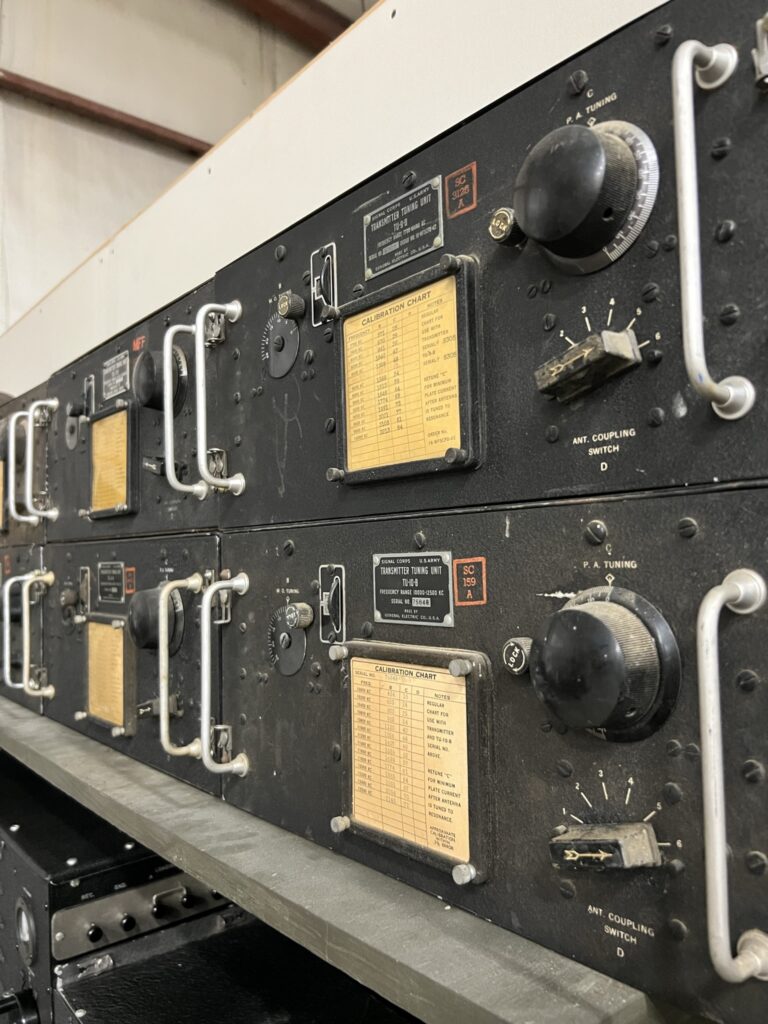
Jeremy Schotter’s newly-donated TU-7-B blends right in with the other tuning units for Lucky Thirteen.
Previously we had mistakenly acquired a TU-7-N, which was inaccurate to our 1943 setup. With Jeremy’s donation, this issue has been fixed.
Photo taken 8 February 2023.
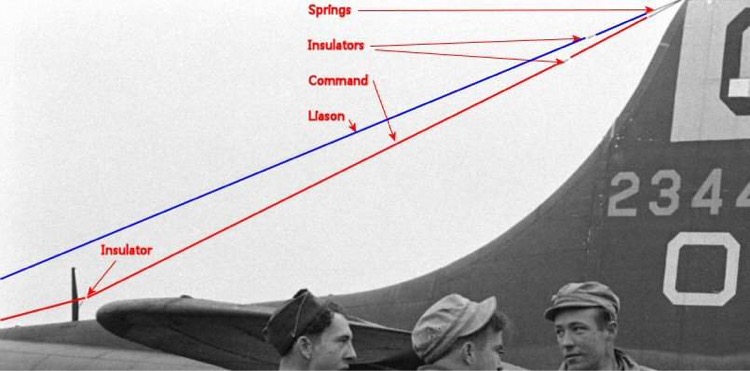
A color-coded photo made by volunteer Karl Hauffe, showing the antenna cables for the SCR-287 Liaison and SCR-274 Command radios. The mast for the SCR-522 is also visible here.
Originally, the Liaison antenna line ran out to the left wing. This surprisingly bad design was quickly rectified at the Cheyenne Modification Center (where the SCR-522 was also installed).

An accessory piece carried on all large USAAF aircraft: the BC-221 Portable Frequency Meter.
This unit was donated by Richard Boyens.
Photo taken 8 February 2023.
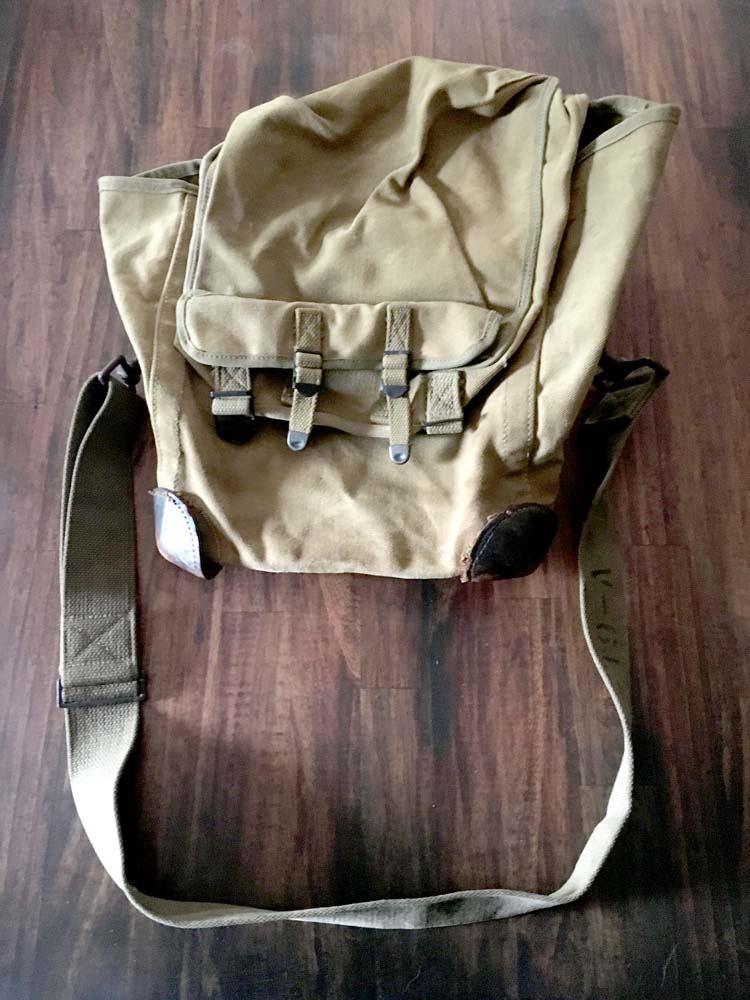
The stowage bag for the BC-221 Portable Frequency Meter.
Photo taken 25 May 2019.
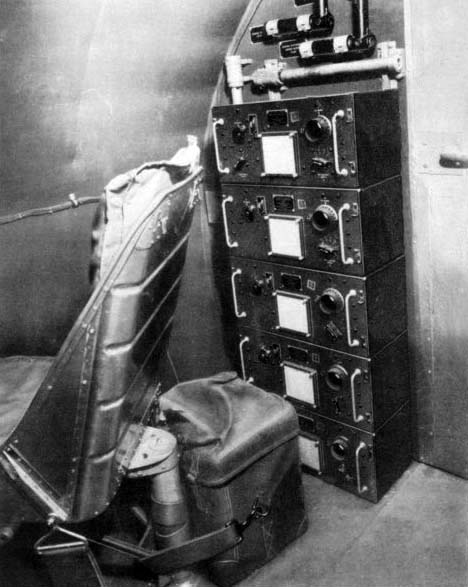
The BC-221 Portable Frequency Meter, in its BG-81 Bag, stowed aboard a Boeing B-17.
While B-17Es and early-Fs came from the factory with a pair of passenger chairs in the radio compartment, these were usually removed overseas. Since crashlanding and ditch procedures required cramming everyone in the radio compartment, the extra seats needed to go.
The aft fuselage of Liberty Belle left Hangar Thirteen 22 February 2023 on its way to Douglas, Georgia to join the rest of the Belle at the the Liberty Foundation. The hangar suddenly feels a whole lot bigger…
This day also saw our friend Eric Miller of Project Warbird donate three metal brakes to the hangar workshop. One of these brakes is massive, measuring some eight feet in length! Special thanks to Eric for these pieces as they will be of immeasurable help to the project.
In case our supporters are curious – yes indeed, contributions of tools and equipment are indeed just as helpful as aircraft parts and financial donations! For example, we currently must send parts out for heat treatment as our facility lacks its own heat-treating oven. Just to give an idea…
The largest of these brakes will be placed where the radio display shelves were originally located. As such, we are moving forth with our plan to move these displays upstairs on the balcony overlooking the hangar.
Lastly, Ray has taken the opportunity to move Station 5 of Lucky Thirteen to another fixture, beginning the process of attaching the carry-thrus. The carry-thrus on the B-17 comprised the lower half of the bomb bay bulkheads and served as the airplane’s backbone. As such, this is a very big deal. Once this section is completed, we can attach the bomb bay, which is currently waiting in the fuselage jig.

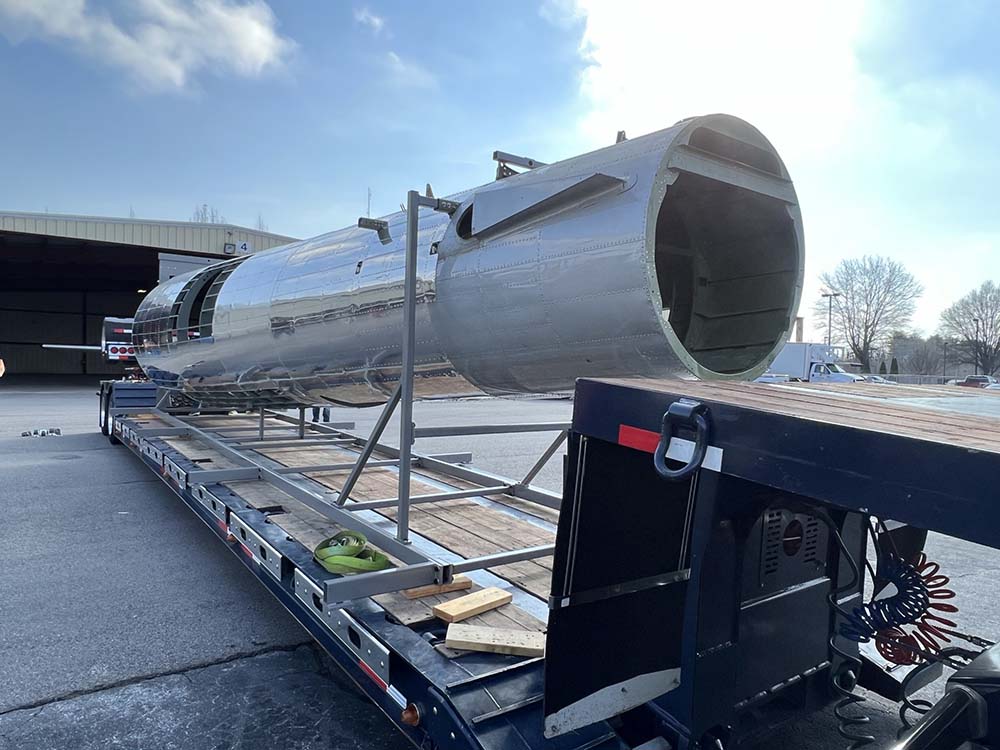
The aft fuselage of Liberty Belle loaded up and ready to travel from Asheville, North Carolina to Douglas, Georgia.
Photo taken 22 February 2023.
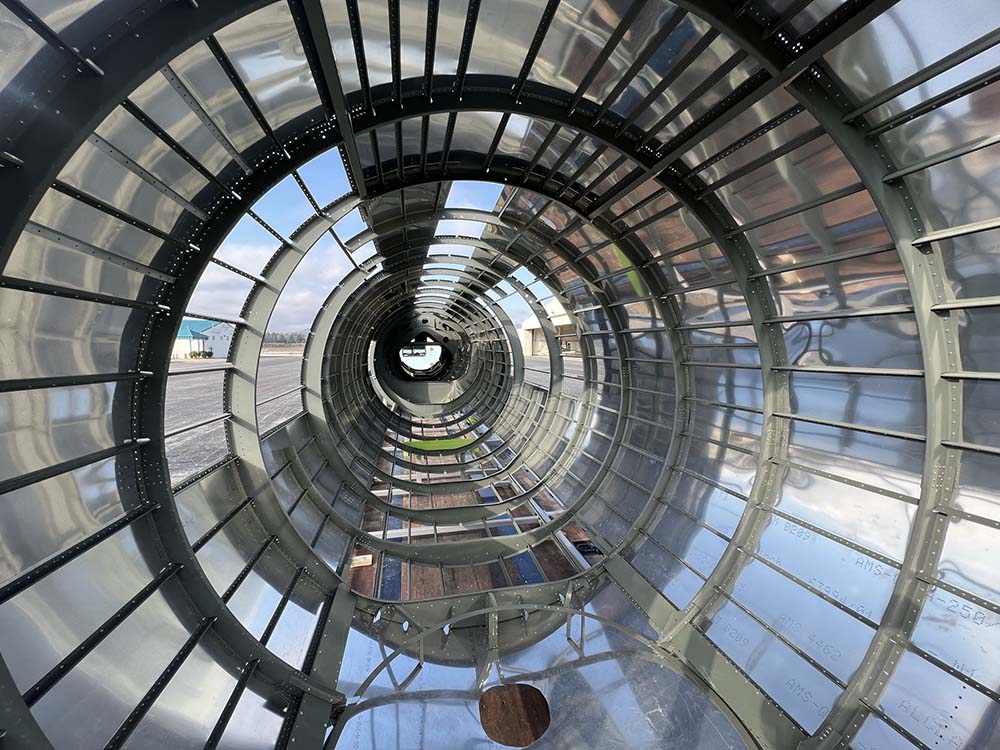
The interior of the aft fuselage of Liberty Belle.
Liberty Foundation volunteers will oversee the installation of the tail gun enclosure, waist gun assemblies, and ball turret support structure.
Photo taken 22 February 2023.

Obligatory selfie with the aft fuselage of Liberty Belle. 😉
Photo taken 22 February 2023.
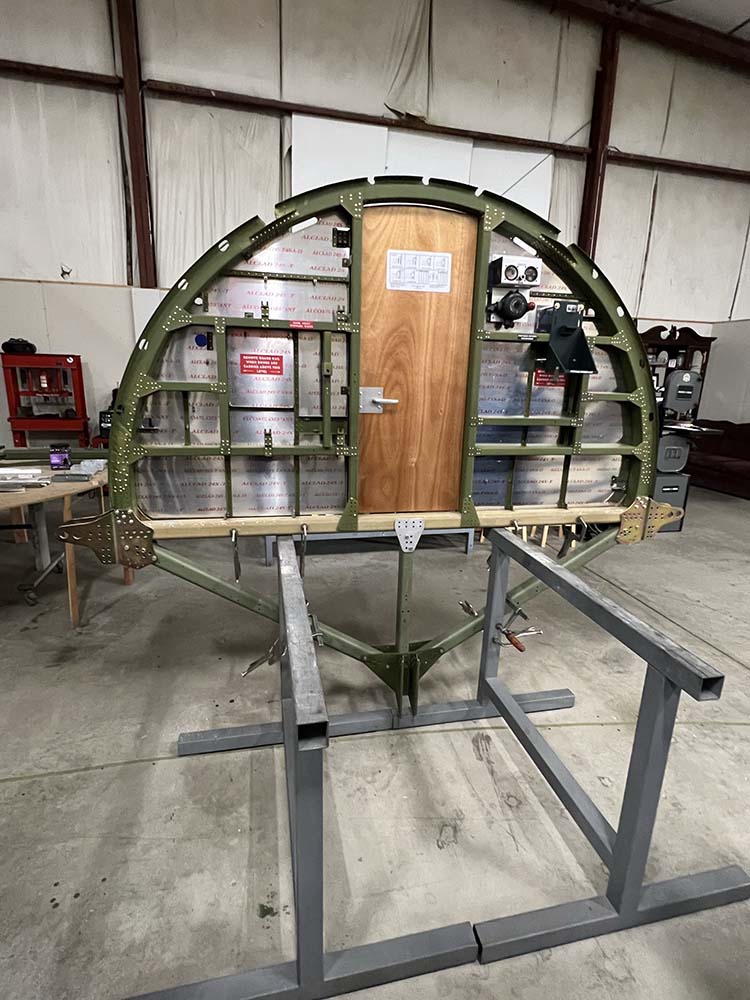
Station 5 to “Lucky Thirteen” with the carry-thrus underneath taking shape.
When working with multiple wreckages, using as many original parts as possible, it is always a thrill when everything lines up perfectly. The attachment points from the bulkhead aligned squarely with the mounting holes in the tubing. No additional fitting was needed.
Photo taken 22 February 2023.
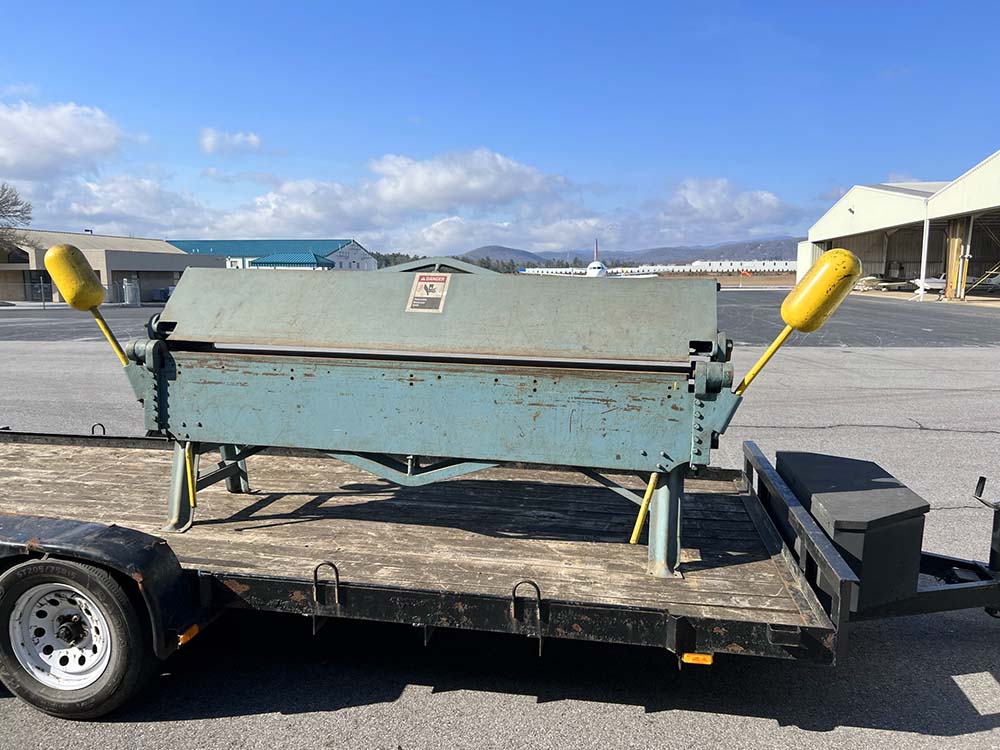
The largest of the three metal brakes donated by our friend Eric Miller.
Photo taken 22 February 2023.
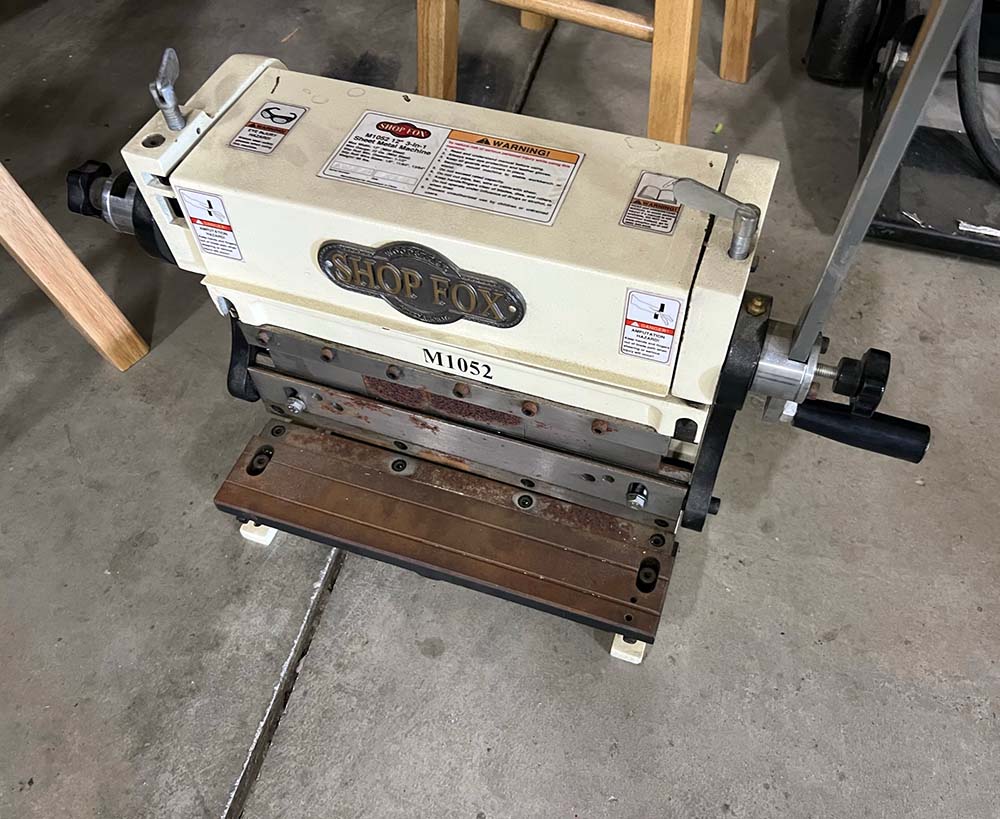
One of the metal brakes donated by our friend Eric Miller.
The third brake went to my home workshop, since much of our volunteer work is long-distance.
Photo taken 22 February 2023.
A few of you expressed surprise when I mentioned the tail gunner’s crawlway door in an update covering the interior doors we built for Desert Rat. During that period, I redid the crawlway door for Lucky Thirteen, so I thought that I might go into more depth here.
This door was unique to E and F-series Boeing B-17s and was mounted to Station 9. The door separated the tail gunner’s compartment from the tail wheel. Our door was built strictly following blueprint spec and was made of 5/16 Douglas Fir reinforced with strips of spruce. Volunteer Bob Hachmann fabricated the hinges and sophisticated dual latch mechanism. In wartime the handles were purchased off-the-shelf from Seattle Hardware, and while said company is still in business, Bob turned new handles after confirming that the company no longer had in storage. You can imagine their surprise when he called…
Some exciting pieces also came from our friends at the New England Air Museum in the form of three unissued autopilot gyros. These gyros were purchased thanks to donations from our supporters, and we cannot thank you enough!
These gyros were critical components of the Honeywell Aerospace Type C-1 Autopilot. The standard autopilot on the Boeing B-17, Consolidated B-24, and Boeing B-29, this autopilot was a sophisticated piece of technology integral to US strategic bombardment operations. Essentially the autopilot’s gyros (one for level flight and one following the bombsight) pulled on the aircraft’s control cables to affect course. As such, each gyro controlled an axis – pitch, roll, and yaw.
To our knowledge, there are only two complete, working C-1 systems in the world today: one in France and one in Australia. It is our goal to restore one in the United States for Lucky Thirteen. So far, the only autopilot component that we have not yet located is the bombsight stabilizer. If anyone can help with this need, please let us know!
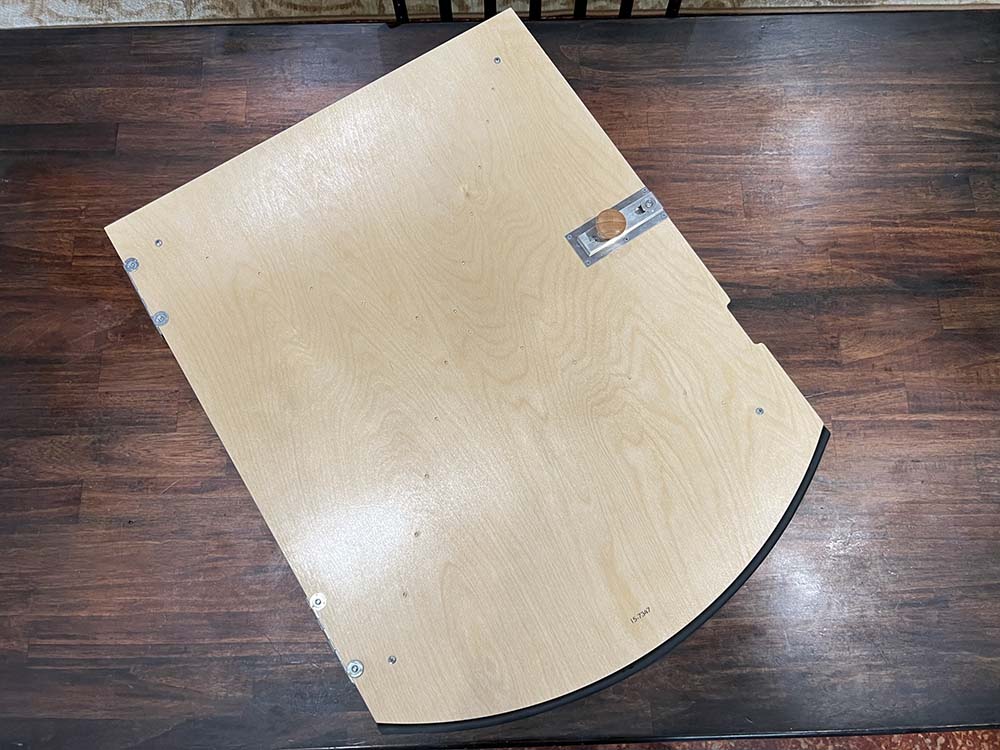
The front side of the newly-finished tail gunner’s crawlway door for Lucky Thirteen.
Photo taken 20 February 2023.
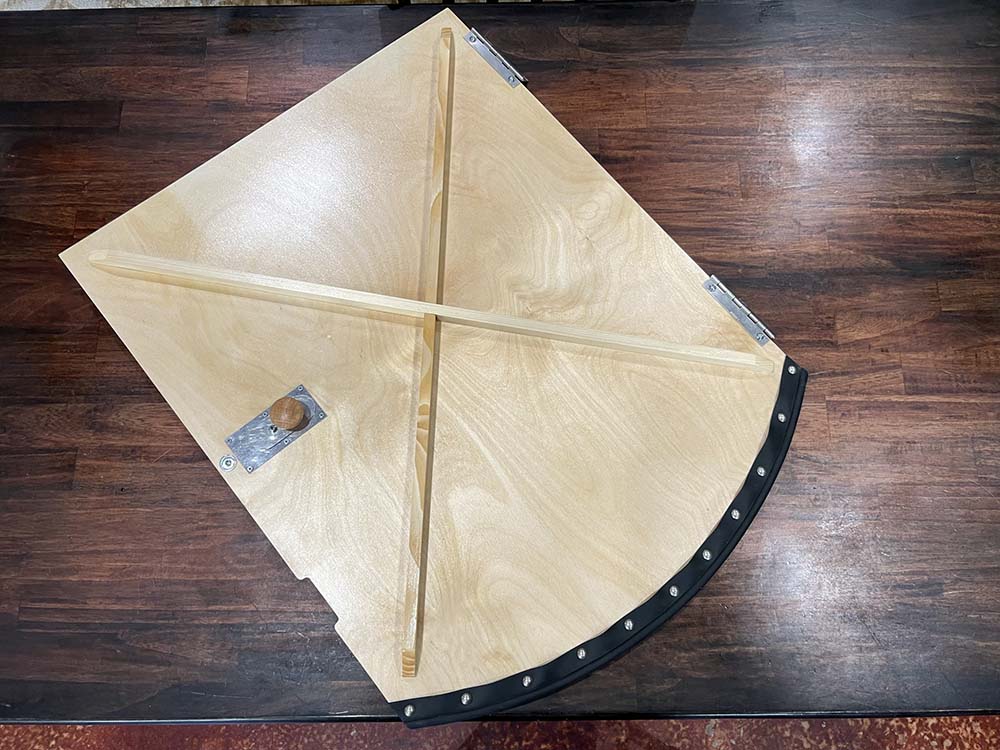
The backside of the newly-finished tail gunner’s crawlway door for Lucky Thirteen.
Photo taken 20 February 2023.
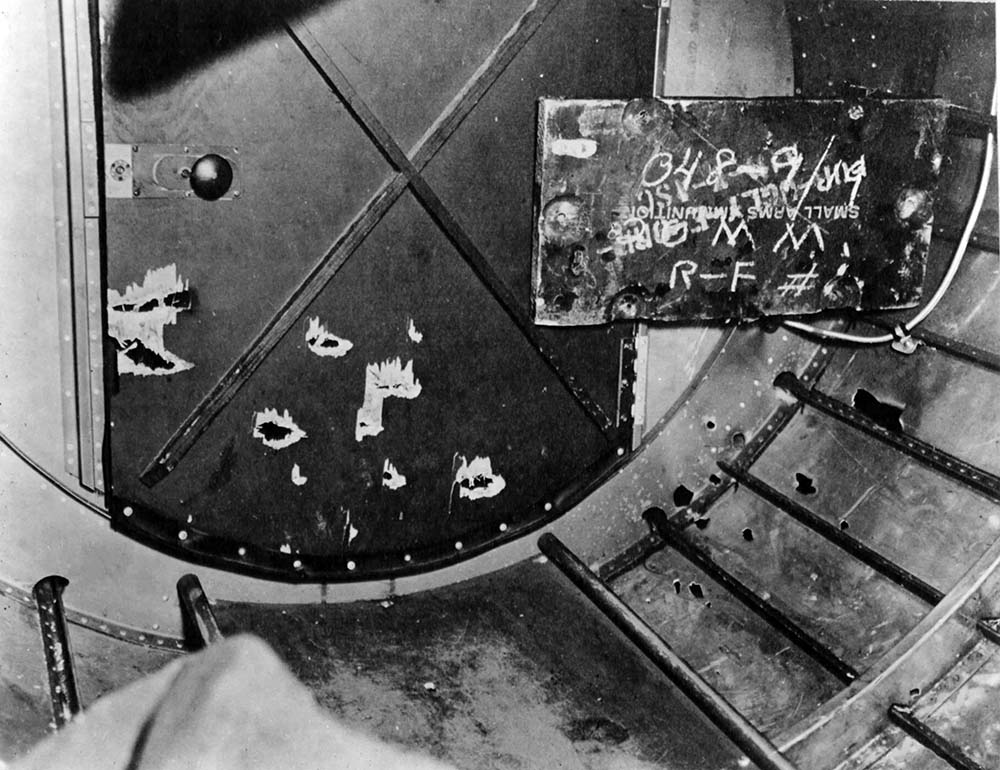
The backside of a tail gunner’s crawlway door, splintered with autocannon shrapnel.
This door has not been finished to blueprint spec. Not only has it been painted, but the rubber weather-stripping has been attached with tacks rather than staples. We elected to follow this photo’s example and use tacks as well, though we left our door natural wood. Period evidence shows that painted doors were a characteristic of Es and early-Fs, and Lucky Thirteen is a late-F.
The object to the right of the door, braced against an oxygen line, is the lid to an ammunition crate.
Photo taken 16 January 1943.

A Boeing employee at work in the tail of a Boeing B-17.
The rearmost bulkhead is Station 11, where the tail stinger assembly attaches. Ahead of her is Station 9, with the opening for the tail gunner’s crawlway door clearly visible.
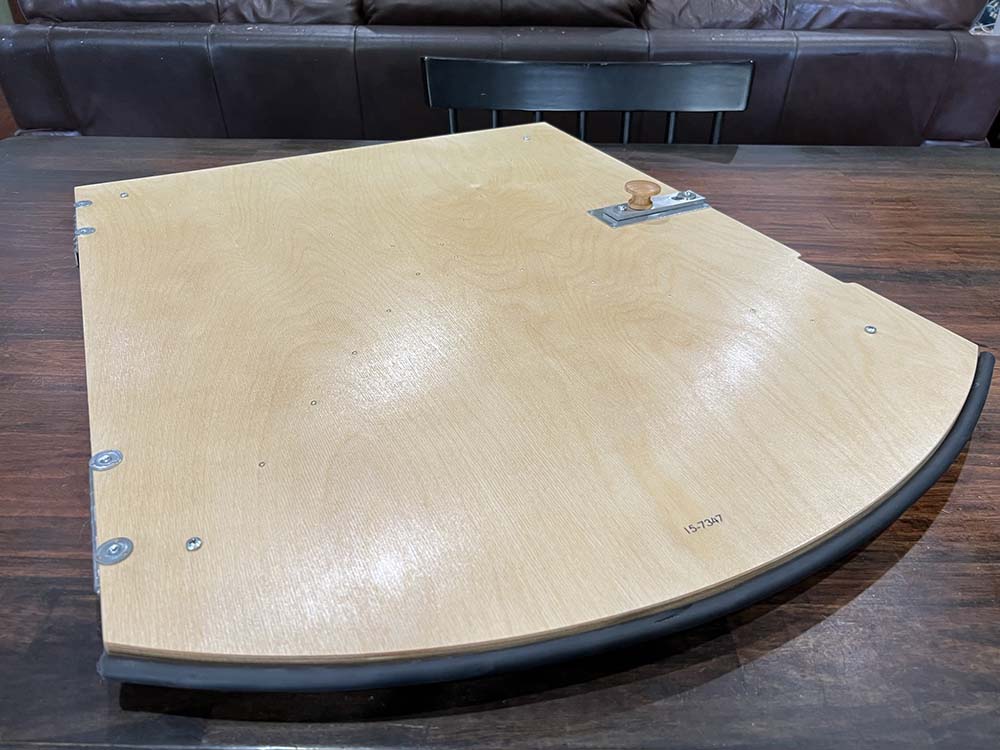
The front side of the newly-finished tail gunner’s crawlway door for Lucky Thirteen.
Photo taken 20 February 2023.
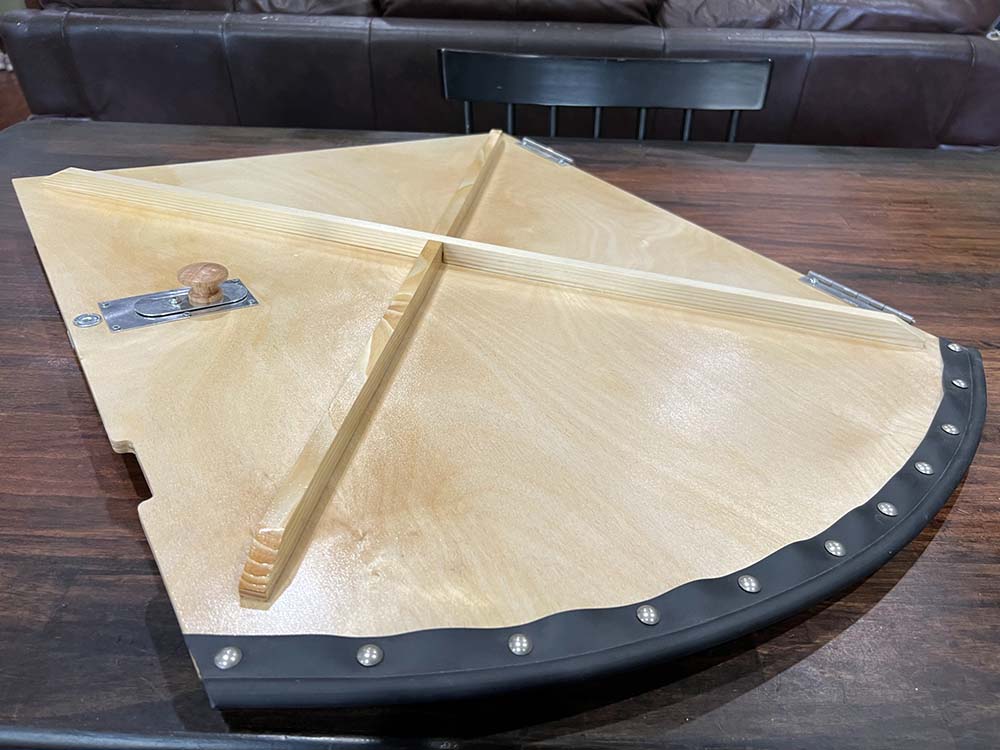
The backside of the newly-finished tail gunner’s crawlway door for Lucky Thirteen.
Photo taken 20 February 2023.
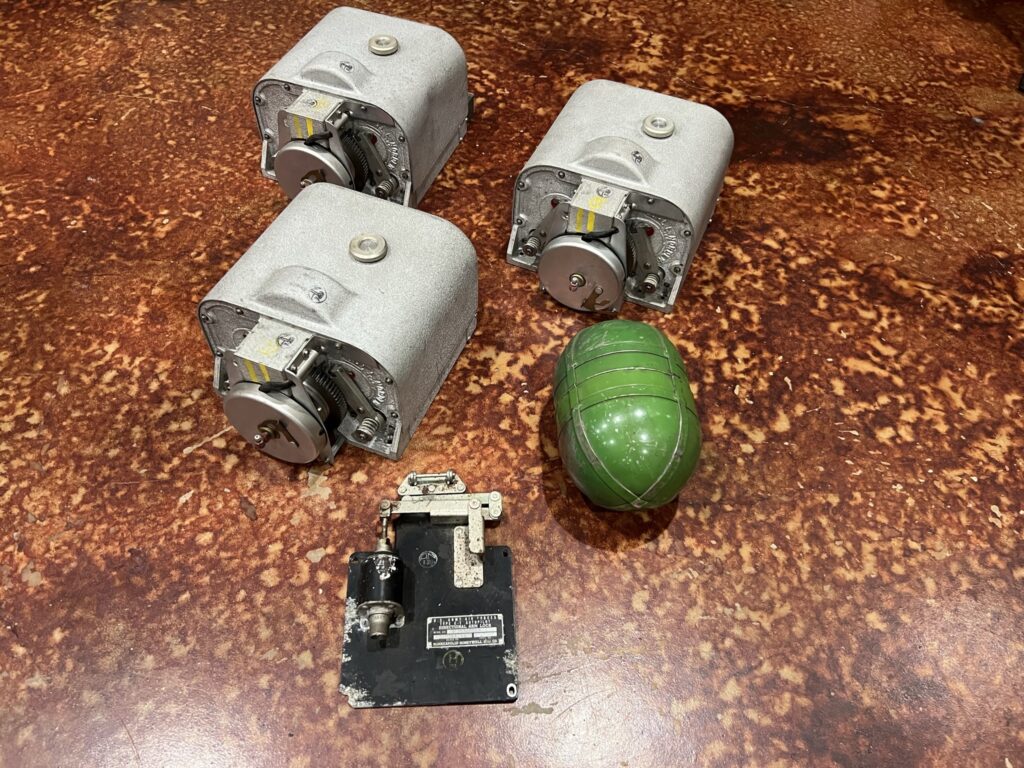
The newly-arrived autopilot gyros purchased from the New England Air Museum thanks to the support of our followers!
The directional arm lock and Type A-4 walkaround bottle were added as donations.
Photo taken 18 February 2023.

Our current progress on the Minneapolis Type C-1 Autopilot System for Lucky Thirteen.
Items highlighted in red have been acquired.
The box below the bombsight stabilizer is a simple junction box and will have to be fabricated.
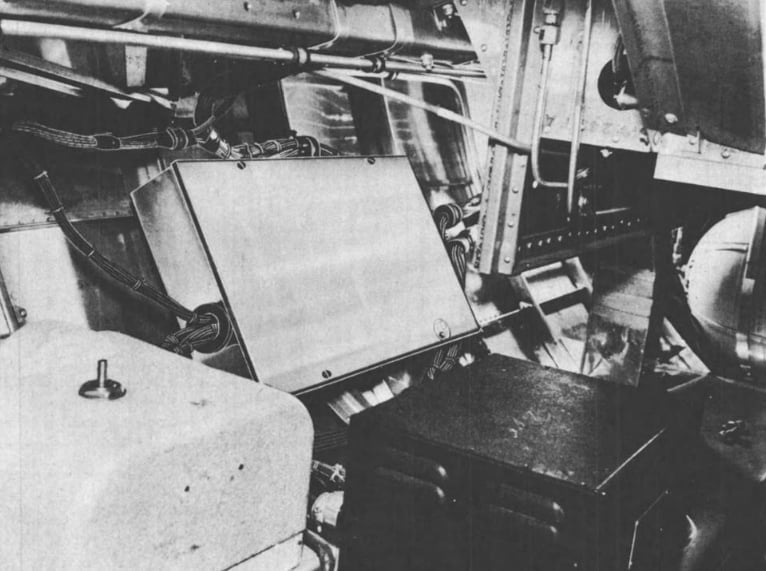
Minneapolis Type C-1 Autopilot equipment, mounted in the crawlway under the cockpit, in the nose of a Boeing B-17F.
Closest to the camera is the servo controlling the aircraft’s ailerons.
The black box is the autopilot’s amplifier and the silver box is the junction box for all the autopilot’s cabling.

The servos for the Minneapolis Type C-1 Autopilot’s rudder and elevators were mounted on a shelf above the aircraft’s tail wheel.
Note the control cable being run through a servo.

One of the first photographs of the Norden bombsight shown to the public, released on 17 November 1944.
Note how the bombsight mounts to the stabilizer below.

An airman walks through the forward radio door of a late-B-17F just like Lucky Thirteen. His Type A-10 mask is connected to a Type A-4 Walkaround Bottle.
Two different variants of A-4 bottle were produced during the war – a solid type and a banded type. The one in this photo is a banded type.
So far, we have acquired two solid A-4s and one banded A-4 (sans regulator). It is our goal to outfit Lucky Thirteen with a full complement of thirteen matching A-4 walkaround bottles.

An unidentified airman squeezes through the bomb bay of a B-17, carrying a Type A-4 walkaround oxygen bottle. This photo was taken from Station 5, looking forward toward Station 4 (the back wall of the cockpit).
The first of the demand-flow walkaround bottles, the A-4 gave the airman between 3 to 8 minutes of breathable oxygen.
Two different variants of A-4 bottle were produced during the war – a solid type and a banded type. The one in this photo is a solid type.
So far, we have acquired two solid A-4s and one banded A-4 (sans regulator). It is our goal to outfit Lucky Thirteen with a full complement of thirteen matching A-4 walkaround bottles.
I could not wait to share these pics –
The shelves for the SCR-274 Command Radio system have been fabricated for “Lucky Thirteen.”
The lightening holes will have to wait for the proper tools to arrive at the hangar, then we can have the shelves clear anodized. Still, it is a thrill to see the units in place.
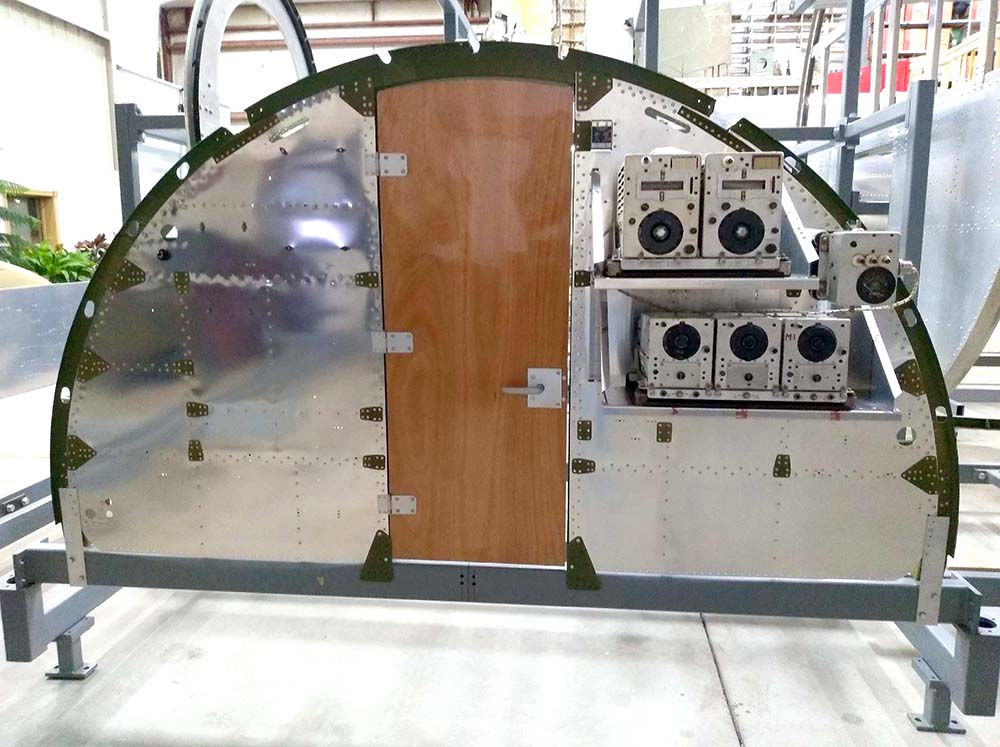
The Command Radio sets temporarily in place on the new Sta. 5 radio shelves.
The upper units are transmitters, the lower ones receivers. The small unit to the side is the antenna relay, connecting to an outside wire which runs up the tail. Power for the system comes from a modulator mounted on the floor and the system is operated by overhead controls in the cockpit.
Photo taken 31 January 2023.
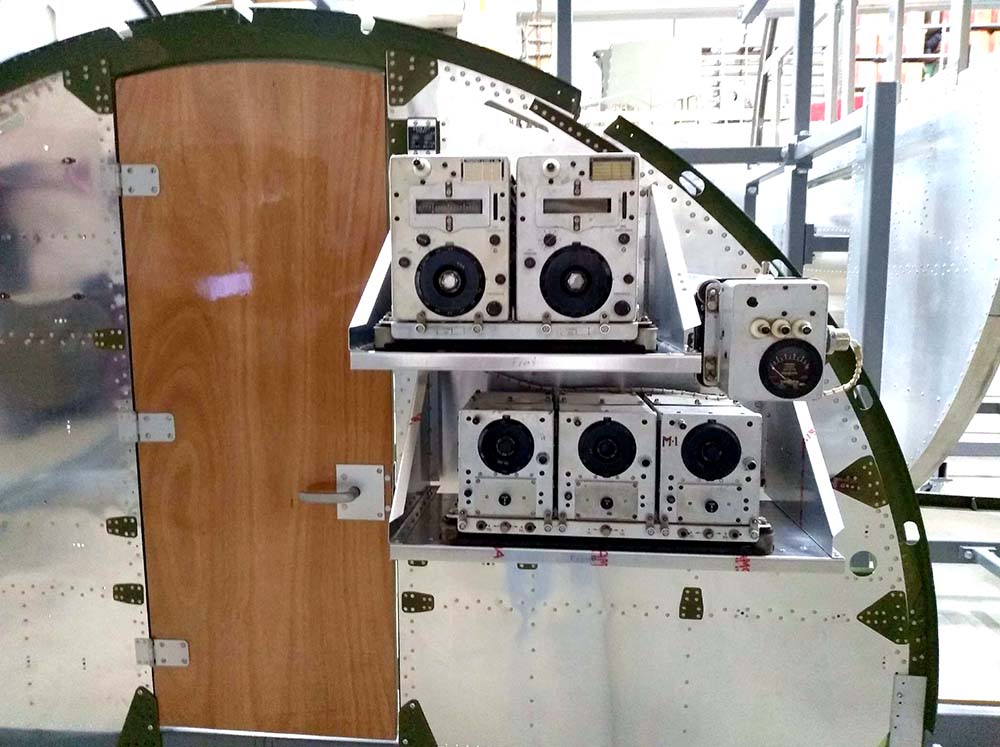
Early war SCR-274 units were painted wrinkle black. In the Spring of 1943, these units were slowly replaced with natural metal sets.
Since Lucky Thirteen entered service in the summer of 1943, she almost certainly had a silver SCR-274 set.
Thanks to hard work by volunteer Charlie Liberto, and a generous donation by Jack Antonio of Warner-Robins, Georgia, this set is completely operational. Likewise, it fully matches wartime spec – there are no HAM modifications to any of these units.
Photo taken 31 January 2023.
Some incredible donations for Lucky Thirteen:
First up is pair of replica AN-M2 .50 cal. MGs from our friend Rian Olsen. Rian’s family were changing things up and he no longer had time to finish the pair. This was perfect for Hangar Thirteen volunteer Bob Jacoby, as fabricating replica .50s has long been one of his goals. So, it was just a matter of getting them from Rian to Bob – and now they are here.
Bob has a great many projects underway, the biggest of which are fabricating Type E-12 gun cradles. Bob was able to measure off an original, and his references were used to fabricate the replicas used in the upcoming “Masters of the Air” series. He is currently working on the E-12s for Lucky Thirteen and Desert Rat. Rian’s contribution should go a LONG way toward helping that project. Thanks buddy!
Second is a lens assembly to a Sperry Type K-3/K-4 gunsight donated by David J. Green. Some of you might recall that we recently acquired an early-variant K-3 gunsight for the aircraft’s top turret. Unfortunately, this sight was missing its glass lens and one of the two right angle attachments. David learned of the missing lens and offered an untouched lens assembly. It is a beautiful piece and turret expert Fred Bieser has offered to install it and power up the sight for a thorough inspection. Looking forward to it! Thanks David!
11 January 2023 saw a trip to the hangar to drop off some parts. While there I installed the last of the markings on the bomb bay side of Sta. 5 and took some beauty shots of our work on Lucky Thirteen. I hope everyone will enjoy!
Lastly, our friend Bobby Poston invited us Saturday to the Triple Tree Aerodrome in Woodruff, South Carolina for the Frosty Dog get-together. That was an incredible experience! Triple Tree is a hidden gem of a location, boasting the largest grass runway in the United States. The site hosts regular events for R/C and general aviation, with onsite facilities for restoration, eating, and public speaking, and is actually a 501c3 nonprofit dedicated to aviation-based education for our nation’s youth. Because we are a small group and work takes up so much of our time, we do not get out much. However, Triple Tree is so close, the area so beautiful, and the people so welcoming, that we definitely want to attend some future event. Just have to get the timing all sorted out!
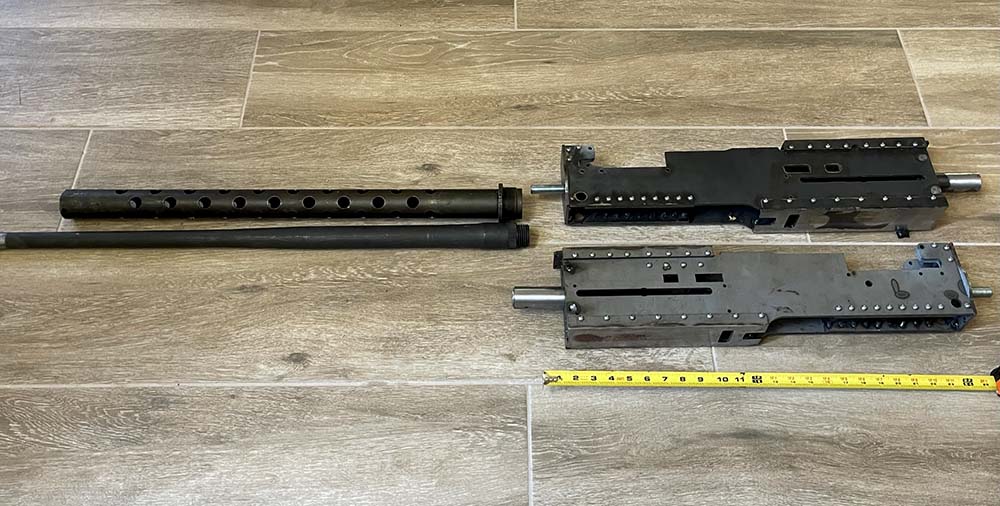
Rian’s newly arrived replica .50 cals with an original barrel and heat shield laid beside them.
Photo taken 15 January 2023.
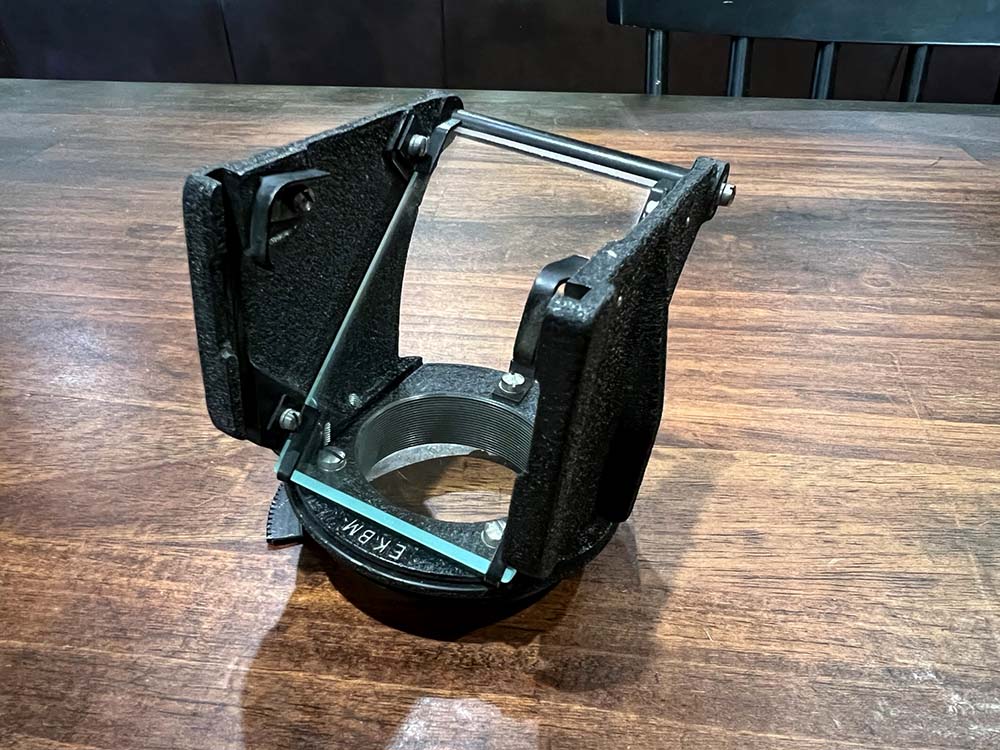
David’s newly arrived Type K-3/K-4 gunsight lens assembly. Truly a beautiful piece.
Photo taken 13 January 2023.
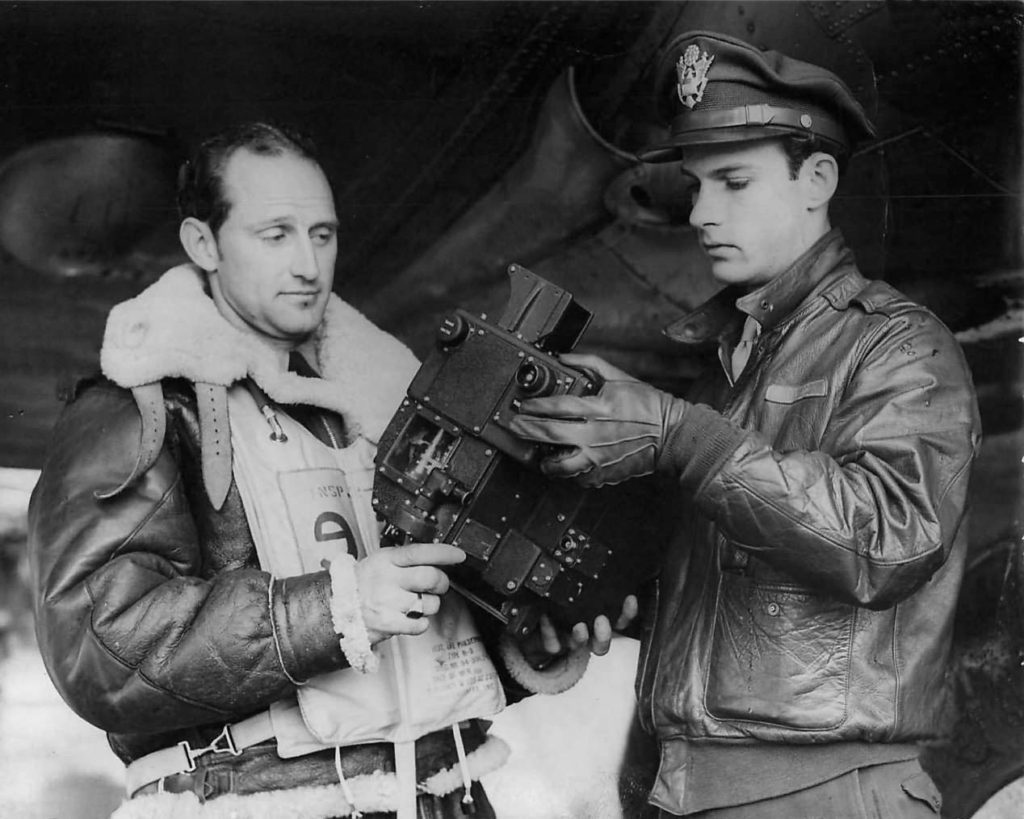
Airman of the 306BG pose with an early-variant Type K-3 Gunsight.

The bomb bay side of Sta. 5 for Lucky Thirteen.
Since Lucky Thirteen was a Douglas-built B-17, we have followed Douglas practice of dipping ribs and stringers in zinc chromate. We have painstakingly recreated the ALCLAD stamps on the bare aluminum skins. Contrary to popular belief, B-17s did not have painted interiors.
Photo taken 11 January 2023.
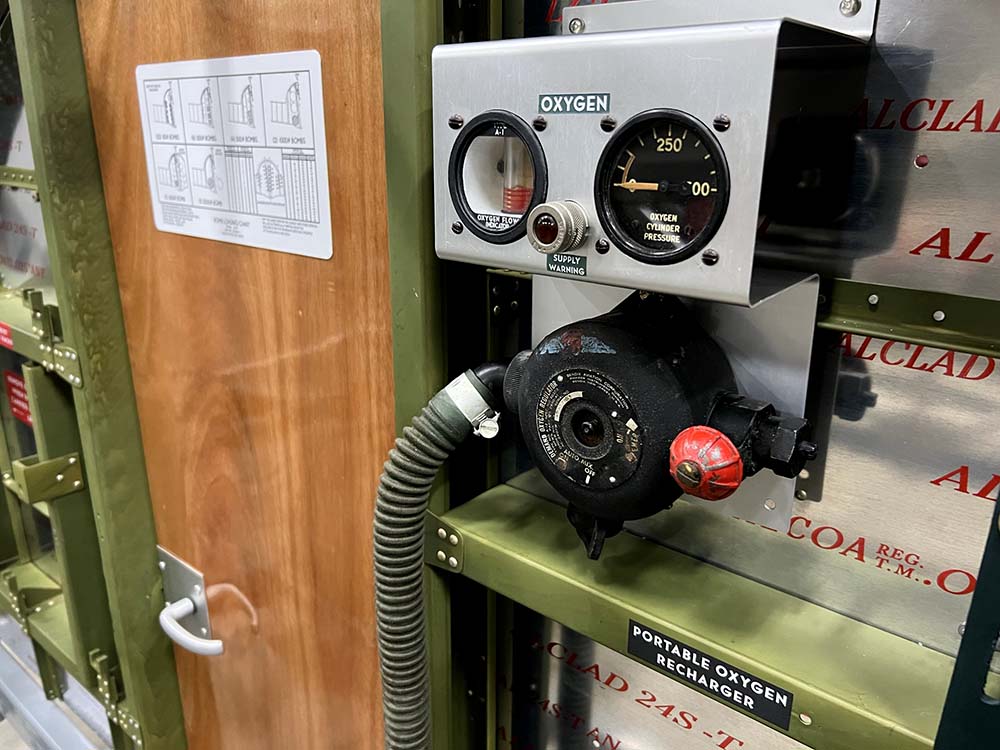
Close-up of the oxygen panel on Sta. 5 for Lucky Thirteen.
This setup was unique to F-model B-17s.
Photo taken 11 January 2023.
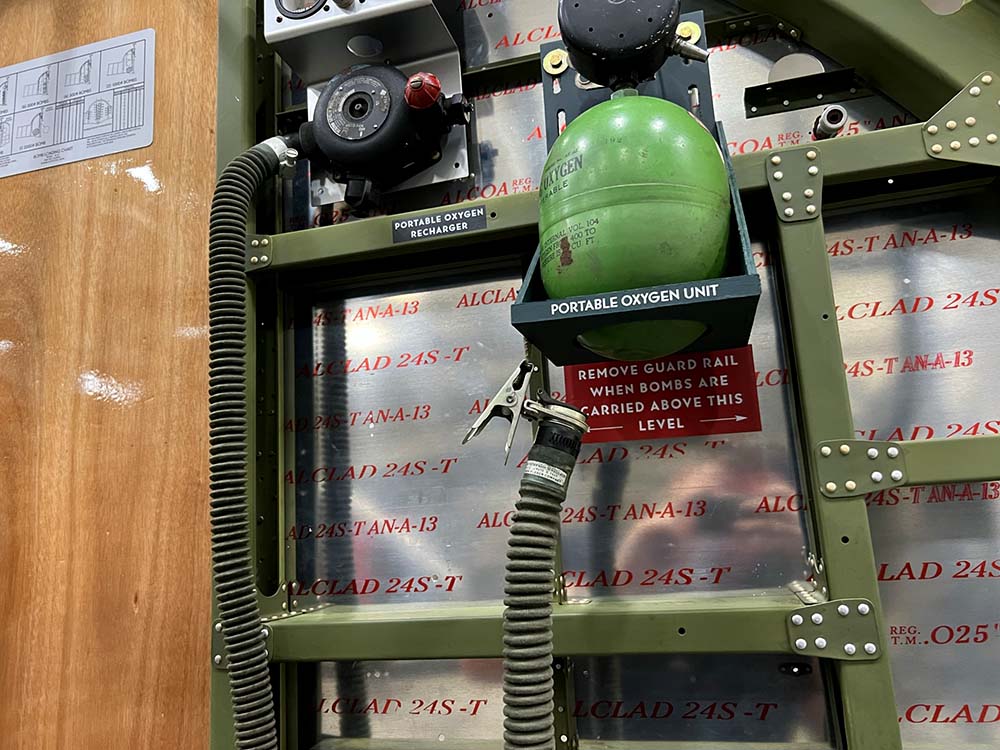
The Type A-4 Walkaround Oxygen Bottle stowed on the bomb bay side of Sta. 5 for Lucky Thirteen.
Lucky Thirteen was originally equipped with 13 Type A-4 bottles. While we have a full set of brackets, we only have two bottles so far.
Photo taken 11 January 2023.
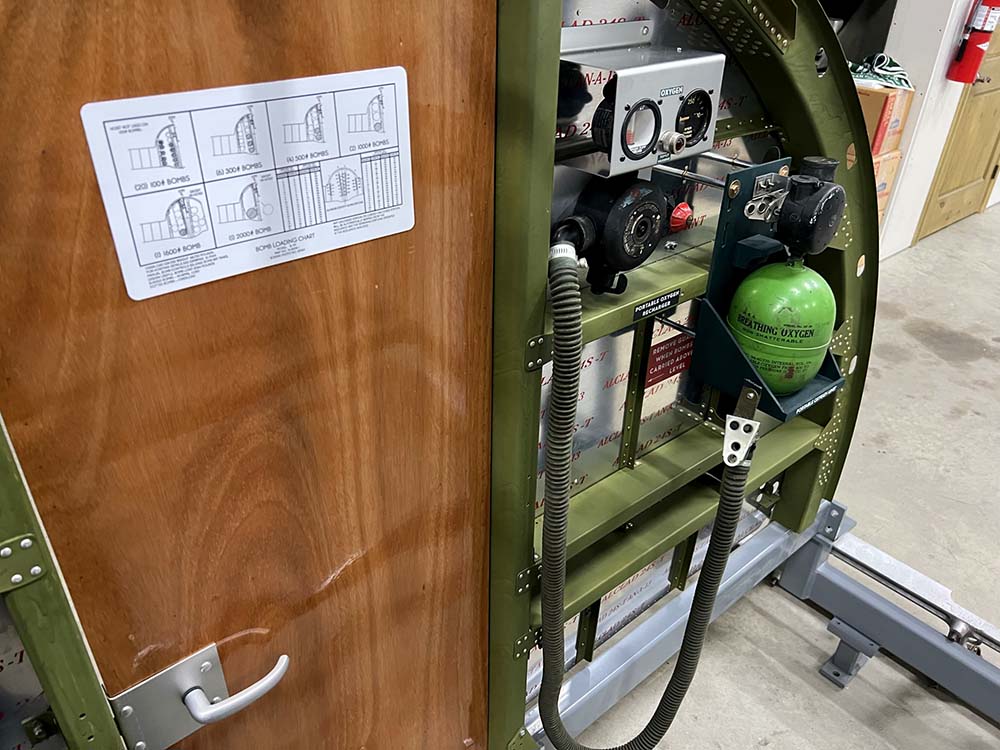
The bomb bay side of Sta. 5 for Lucky Thirteen.
The chart on the door contains instructions for loading various bomb types aboard the aircraft. While the recommended weight was 4,000 lbs, the aircraft could accommodate up to 6,000 lbs internally.
A pair of external racks, inboard of engines 2 and 3, could carry an additional 8,000 lbs, though these racks were rarely used as they greatly affected performance.
Photo taken 11 January 2023.

Close-up of the bomb bay side of Sta. 5 for Lucky Thirteen.
These clips held the bomb hoist rack when it was not in use.
Photo taken 11 January 2023.
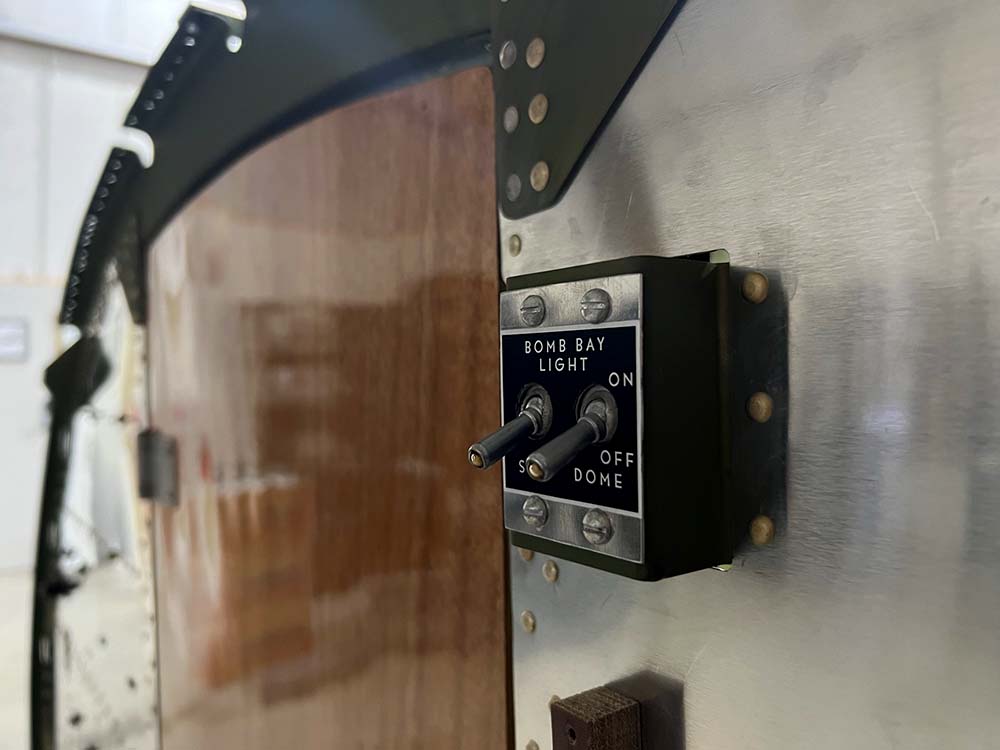
Close-up of the bomb bay light control on the radio compartment side of Sta. 5 for Lucky Thirteen.
The bomb bay held a pair of overhead lights for loading in the pre-dawn hours. If any of you are fabricators nervous about volunteering, the brackets for those lights would be a great first project!
Photo taken 11 January 2023.
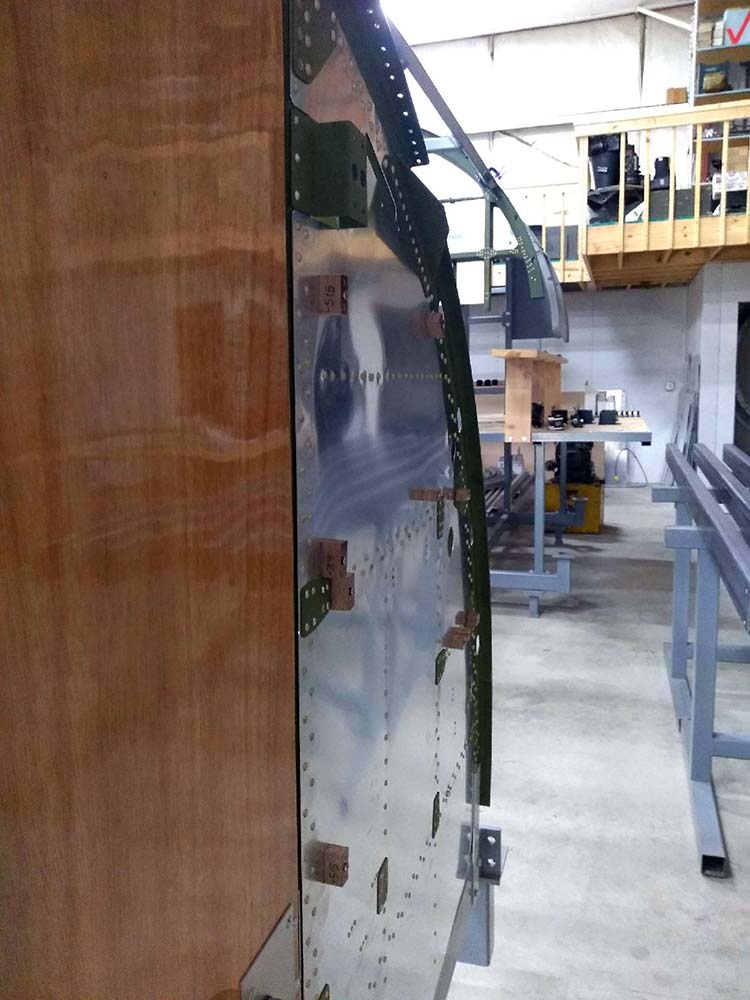
The recently cut phenolic spacers for Sta. 5 of Lucky Thirteen now installed.
These spacers were only found on aircraft with insulated radio compartments (which was standard until the G-series) and were used to hold the SCR-274 radio shelves.
Photo taken 6 January 2023.
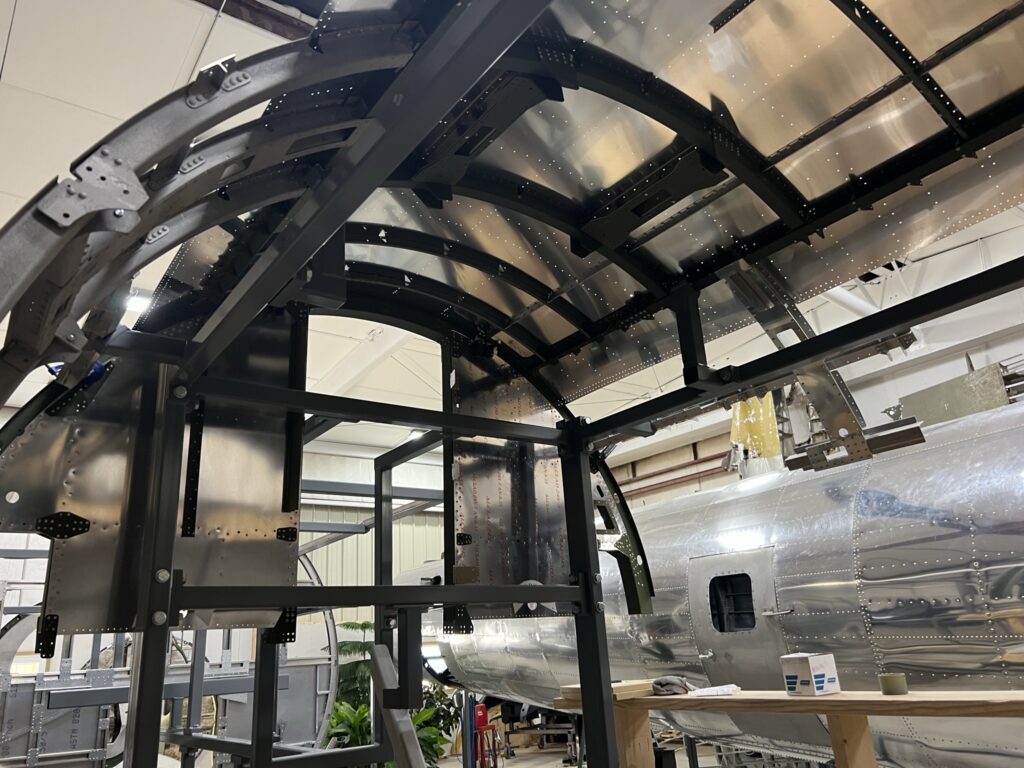
The bomb bay of Lucky Thirteen in progress.
Photo taken 2 December 2022.
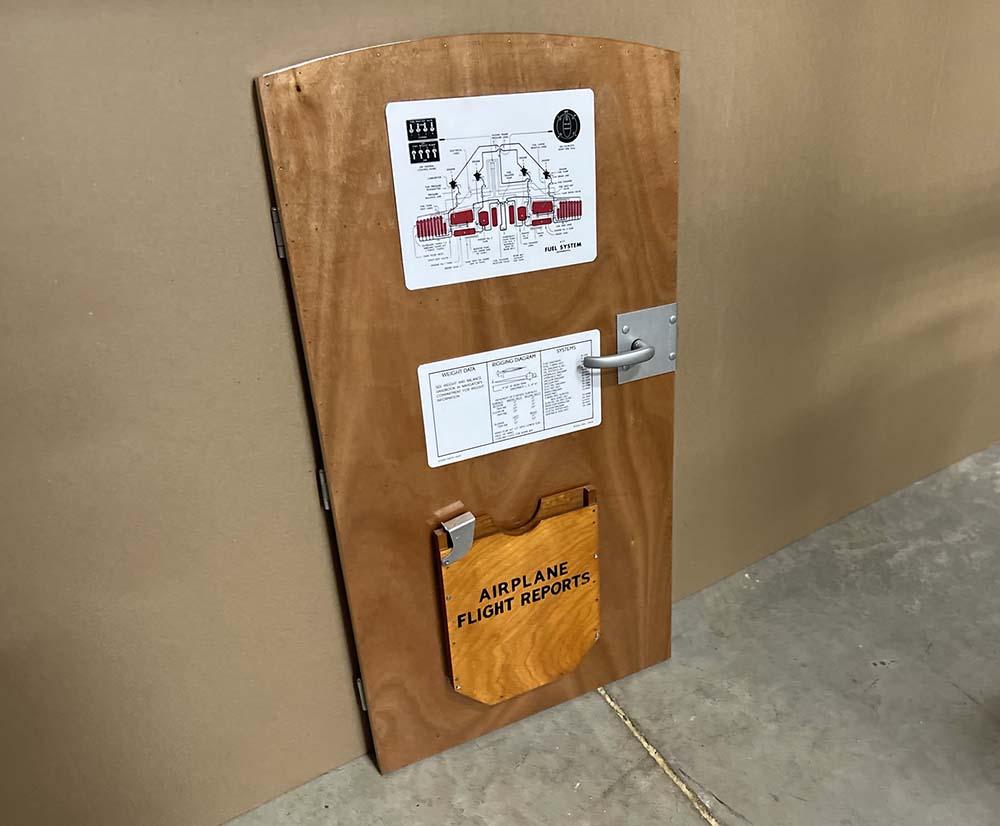
The cockpit door of Lucky Thirteen.
The upper chart is a fuel system diagram, the lower chart a listing of the system blueprints applicable to the aircraft. The Flight Reports Folder at the bottom is wartime original, as is the door’s hardware.
Photo taken 11 January 2023.
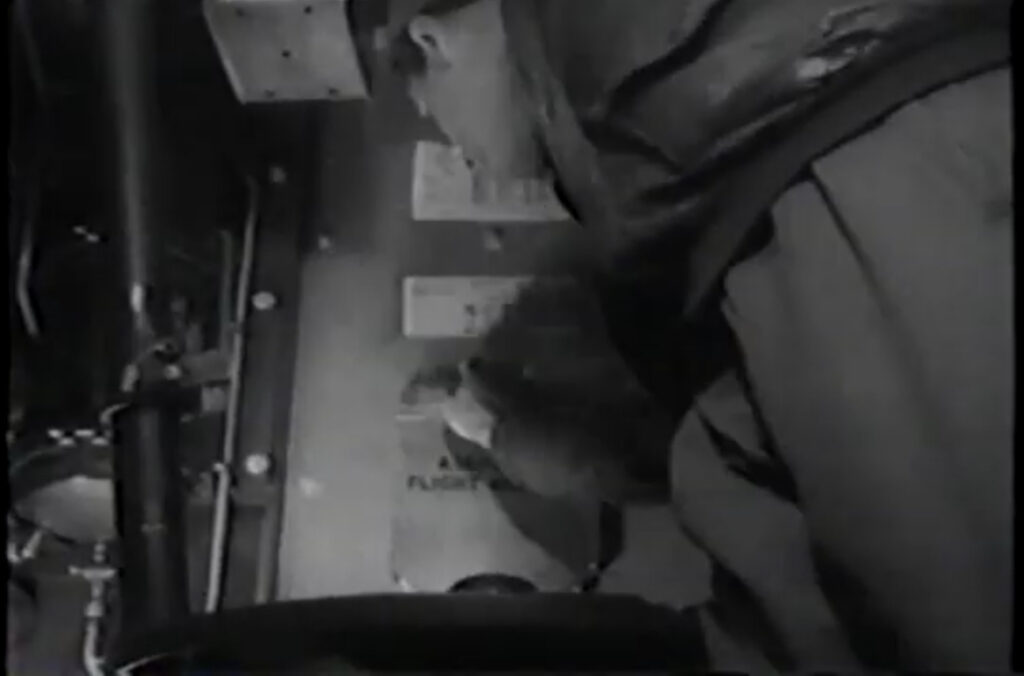
A screenshot from the training film How to Fly the B-17 Flying Fortress which highlights the cockpit door.
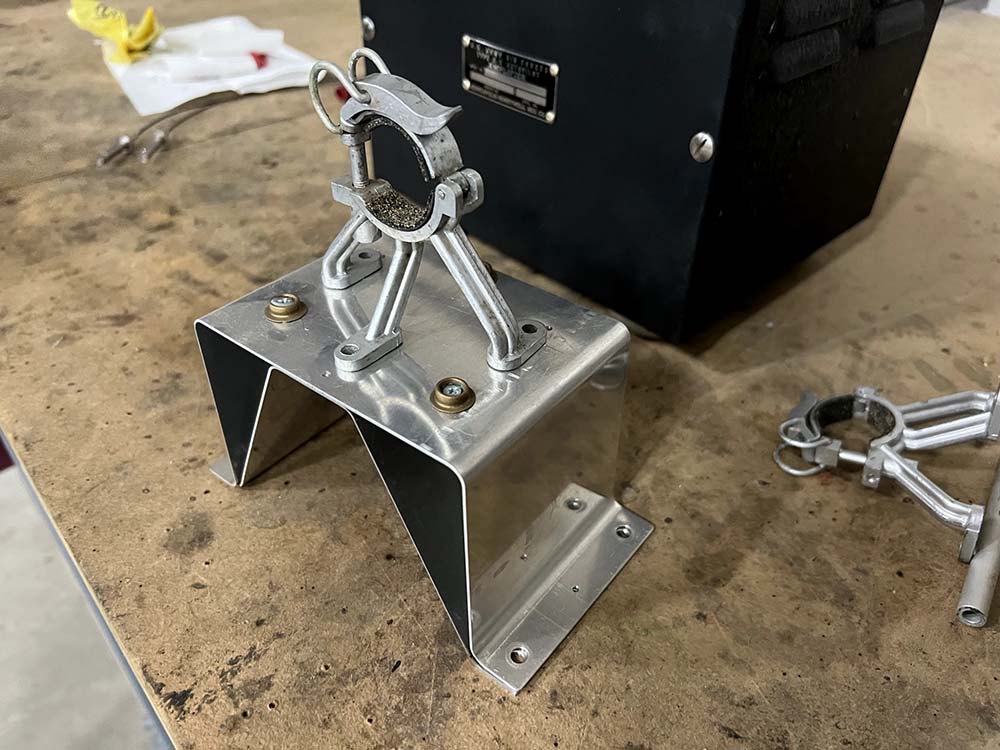
The Sta. 3 bracket for the nose compartment’s fire extinguisher.
This bracket was made years ago using a corroded original as a pattern. The holes line up perfectly.
Photo taken 11 January 2023.

Wartime photo of the Sta. 3 fire extinguisher in place aboard a B-17F.
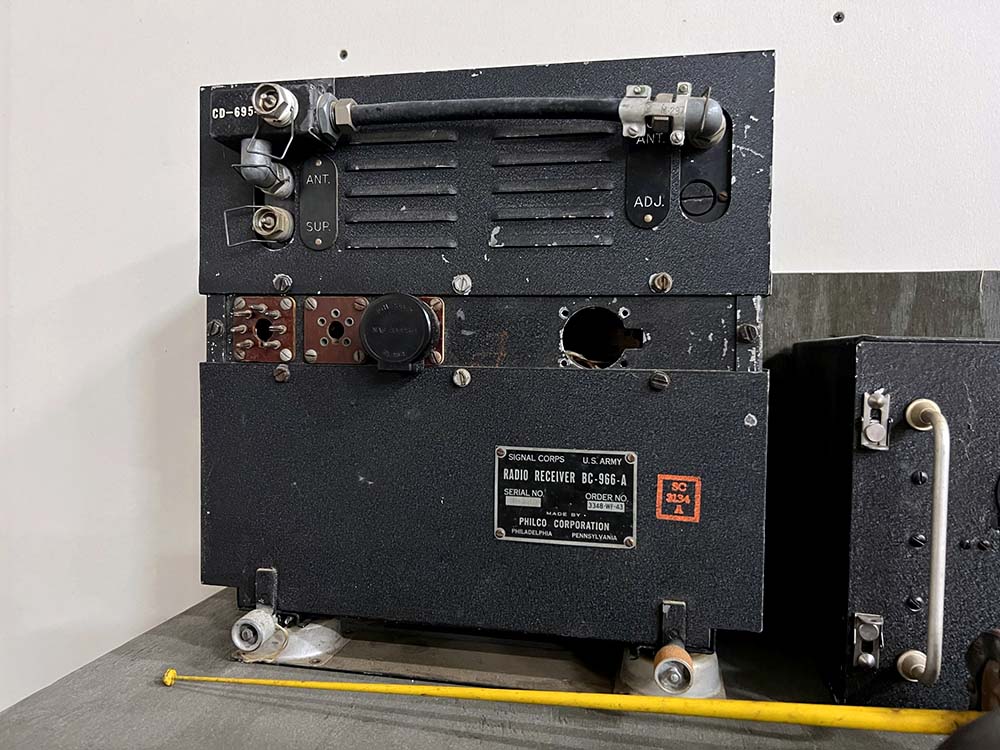
Because of Ray’s recent work on Sta. 5, volunteer Charlie Liberto brought by the aircraft’s SCR-595 IFF (Identify Friend or Foe) system.
This is one of the rarest pieces in our collection. It was donated by Jack Antonio and is fully functional, coming with a test kit to show its operation.
This is the IFF’s transponder unit. The hole on the right held an explosive self-destruct charge. The guys at the Warbirds Of Glory Museum are currently working to fabricate a replica charge.
Photo taken 11 January 2023.
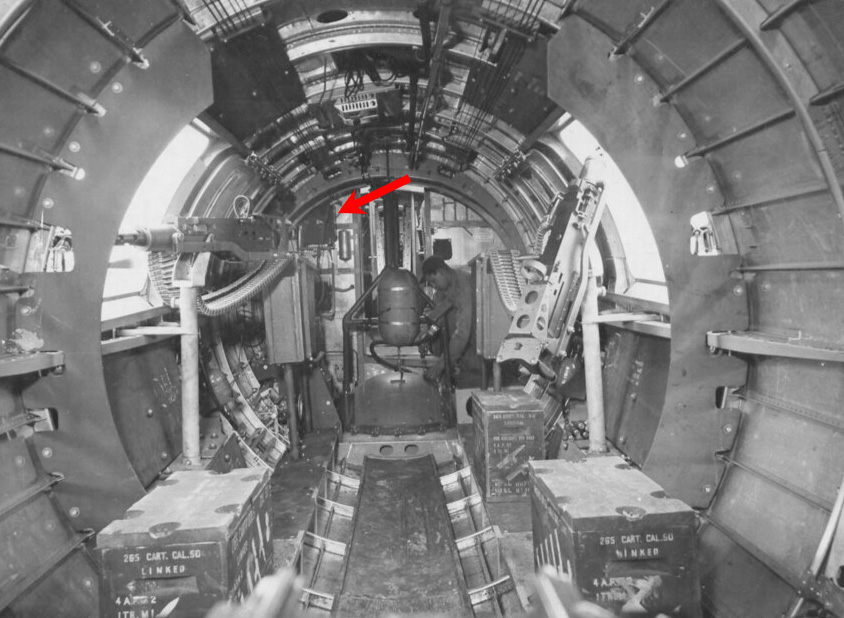
Wartime photo of the B-17’s IFF transponder in place on Sta. 6.
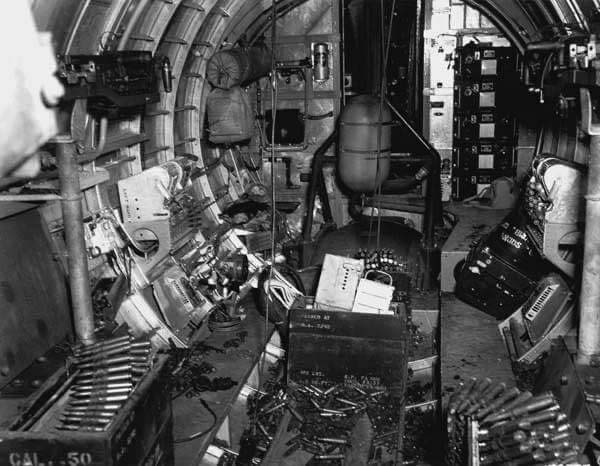
The IFF system was considered top secret as the frequencies it used to differentiate friend from foe for Allied radar operators could not be allowed to fall into Axis hands.
As such, IFF components were not supposed to be photographed. Note how the transponder has been removed for this photo.
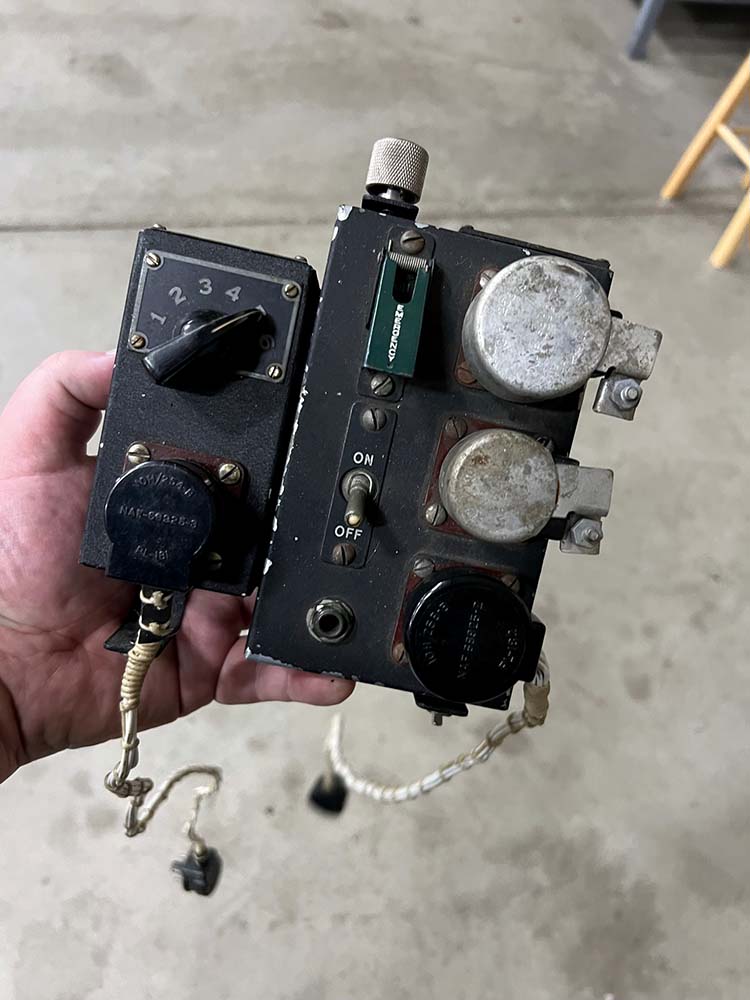
The SCR-595 IFF Selector and Power Control Box.
Photo taken 11 January 2023.

A rare wartime photo – taken aboard a G-model B-17 – which shows the IFF control assembly above the radio operator’s desk.
Note the Type A-2 Carbon Tet. Fire Extinguisher. Volunteer Chris Ely is working to restore the two carbon tet. extinguishers for Lucky Thirteen. If you have any components which can help in this effort – both regarding the carbon tets and the Type A-17 CO2 types – please let us know!
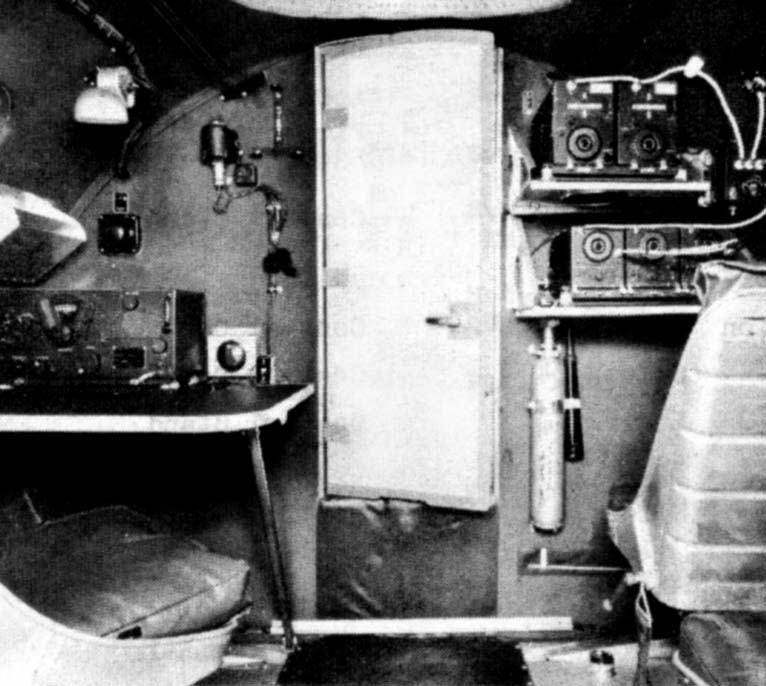
A factory photo of Sta. 5 aboard an E or F-model B-17.
Note the T-bracket above the radio operator’s desk. The IFF controls have been removed for the photograph.
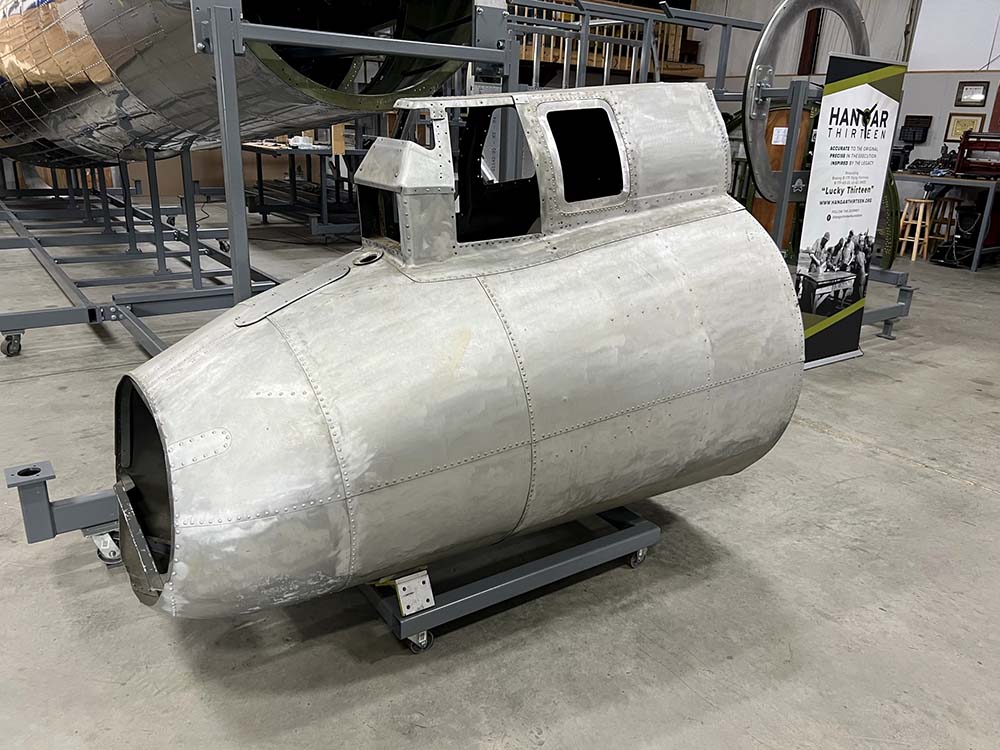
The tail stinger for Lucky Thirteen, now sitting in its own little jig.
Photo taken 11 January 2023.
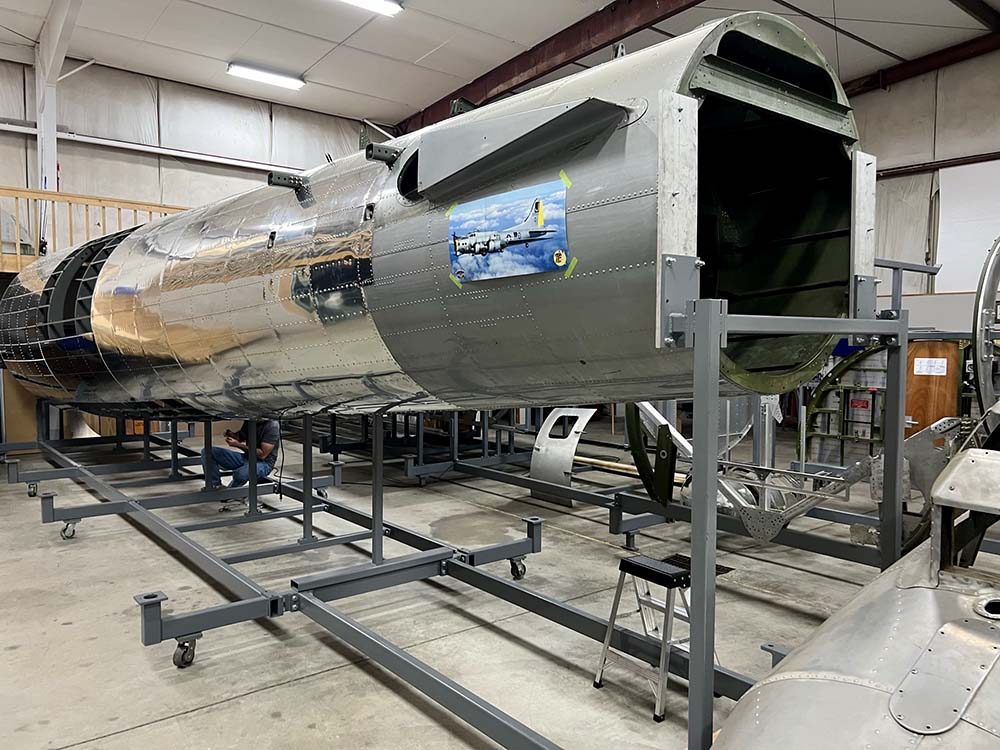
Progress on the aft fuselage of Liberty Belle is cruising along.
While we await her transfer to Douglas, Georgia, work continues on small areas here and there.
Photo taken 11 January 2023.
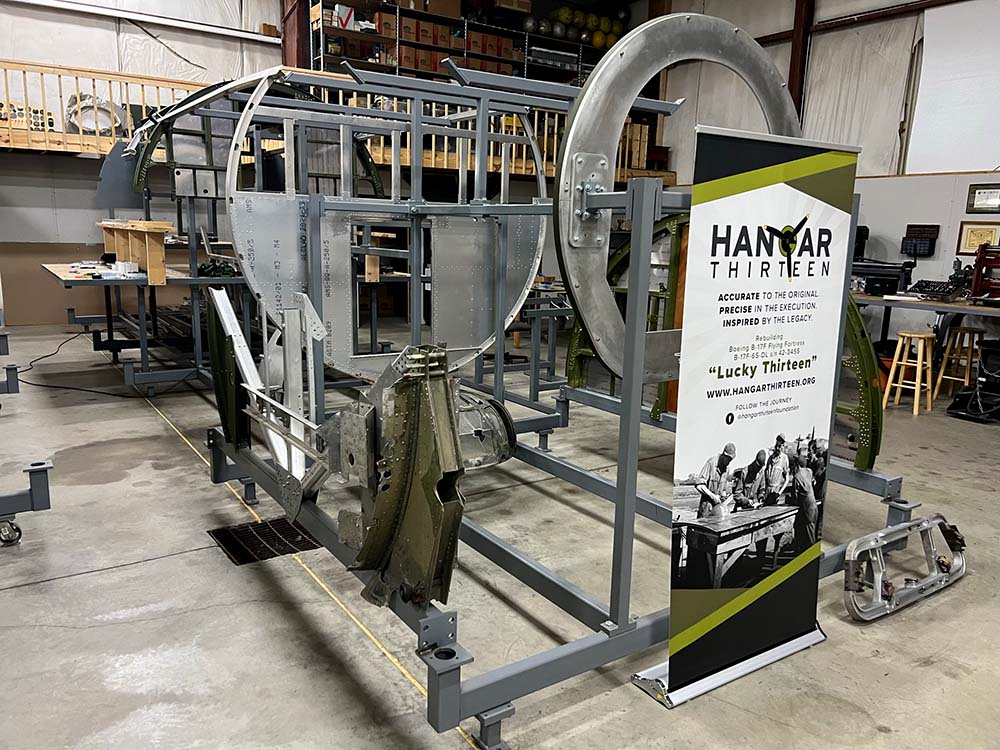
Progress on the forward fuselage of Lucky Thirteen proceeds, slowly but surely.
A carry-thru spar assembly sits close to the camera.
Photo taken 11 January 2023.

Section of tail fuselage for Lucky Thirteen, awaiting its turn.
Photo taken 11 January 2023.

One of the giant trees for which Triple Tree Aerodrome was named.
Due to the effects of mother nature, this is the only one of the three which still remain.
While already a beautiful sight, the coming of spring will turn all this grass a lush green.
Photo taken 14 January 2023.
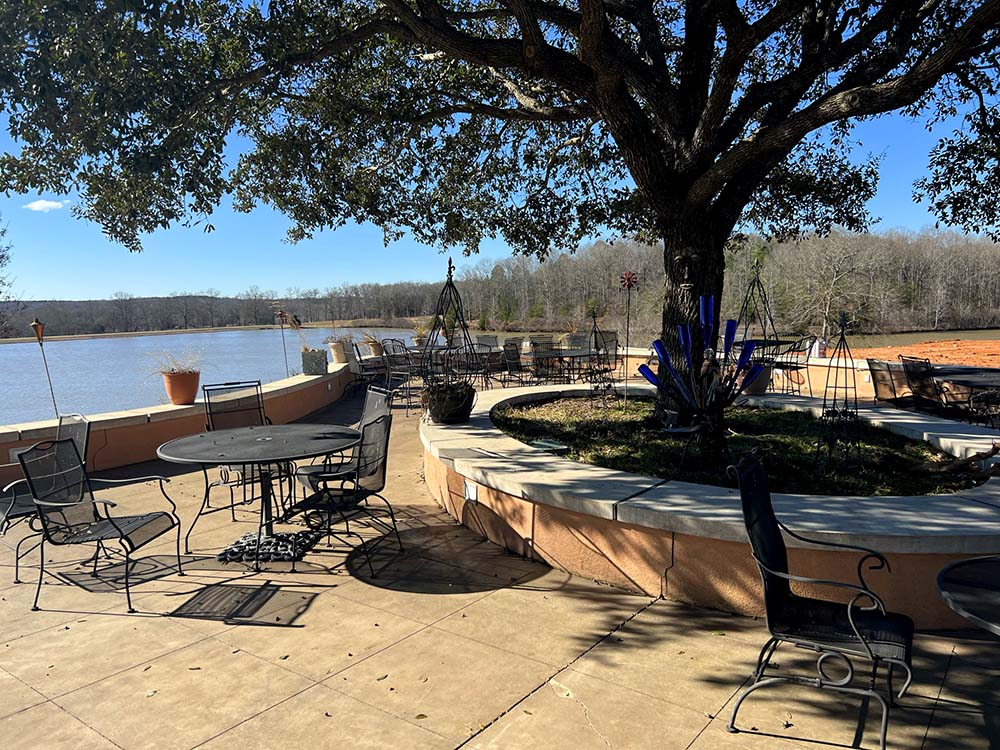
The patio overlooking Triple Tree Aerodrome’s manmade lake.
The lake is used for R/C pilots flying float and flying boat type aircraft.
Photo taken 14 January 2023.
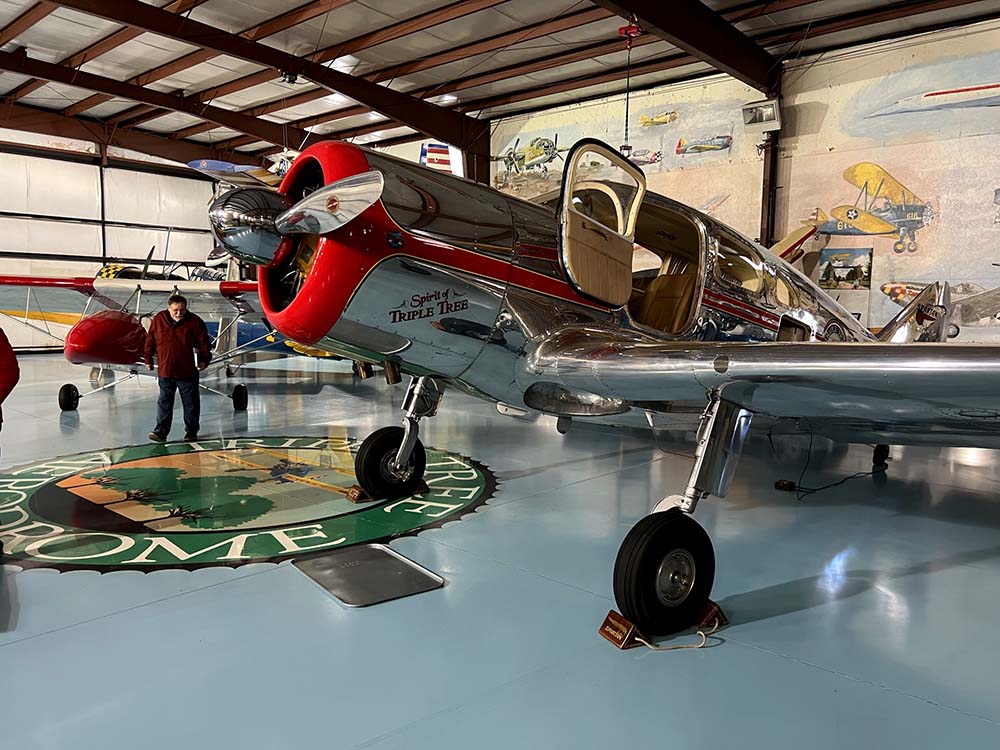
Tripe-Tree Aerodrome founder Pat Hartness oversaw the restoration of this rare 1937 Spartan Executive.
This aircraft was number 13 out of 37 built.
Photo taken 14 January 2023.

A Vultee BT-13 in the main hangar at Triple Tree Aerodrome.
Had to send this picture to our friend Eric B Miller of Project Warbird, who is (amongst other projects) currently working on one of these.
Photo taken 14 January 2023.
